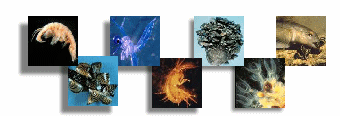Home
Page

Research Interests

Curriculum Vitae

Students

Selected Publications

Media Coverage

Invasive Species

Lab News

|
 |
News & Research Highlights
A NEW
ANNOTATED EDITION OF ELTON'S CLASSIC TEXT
Published this year! The 2nd edition of Charles
Elton’s Ecology of Invasion by Animals and Plants
(EIAP), edited and annotated by me and my colleague
Prof. Daniel Simberloff.
Here's the story of how this new edition came to be.
In May 2016, I was traveling to the UK to give a talk
at the University of Cambridge. I had arranged to
spend a day at Oxford and received permission in
advance to examine the Elton archives at the Weston
Library, to search for background material for a book
on biological invasions that I have long been planning
to write (and still working on).
I was awestruck to find Elton's original proof copy of
EIAP in the archives. It was stuffed with index cards,
reprints, and various typed notes that he used to
inform his book. But these included notes, reprints,
and news clippings post-1958 to the 1980s! Many pages
had Elton's own penciled notes, and he had inserted
reference cards referring to new articles relevant to
each chapter. He kept track of these articles and
organized them in this proof copy for nearly three
decades after EIAP was first published. Although Elton
might have kept track of these for future work, he did
not publish anything on the subject after EIAP. Yet he
kept adding to his proof copy. There were index cards
titled Addenda to "Invasions" (he referred to EIAP as
"Invasions"), which listed numerous topics and cases,
as well as references to articles, books, maps, and
photos that appeared subsequent to publication of
EIAP.
All of this suggested Elton might have been planning a
revised edition. When I returned home, I contacted Dan
Simberloff and told him what I suspected. I proposed
to him that we produce an annotated edition - similar
to what Leibold and Wootton did for Animal Ecology
(2001), but more comprehensive. So Dan and I returned
to Oxford in 2017 to excavate the Elton files
thoroughly. We had wanted the edition ready for the
60th anniversary of EIAP (2018), but negotiations with
publishers went on for months. We finally settled with
Springer, who owned the rights to EIAP. The original
book plates were lost (!), so they scanned the text
and plates from a print copy. Dan and I worked on the
chapter forewords for many months, in between our
other academic and research tasks. Dan revised the
entire back index.
This project was a labor of love. We realized that if
we did this well, it could reintroduce EIAP to a new
generation of ecologists. We spent entire days in the
Elton archives reading every letter, his unpublished
biographical notes, and even his course notes! As
mentioned in the 2nd edn (pp. 233-234), we found notes
for a talk Elton gave in 1967, where he posed the
question of what role uncommon species ("thin food
chains") play in community stability. The role of rare
species and weak interactions in stability is now a
major line of research. Elton's book left an important
impression on Rachel Carson - as she described in a
letter to E.O. Wilson. We made a point of including
many such fascinating details in our annotations to
the 2nd edition of EIAP.
A copy of the book can be purchased here
[April 2020].
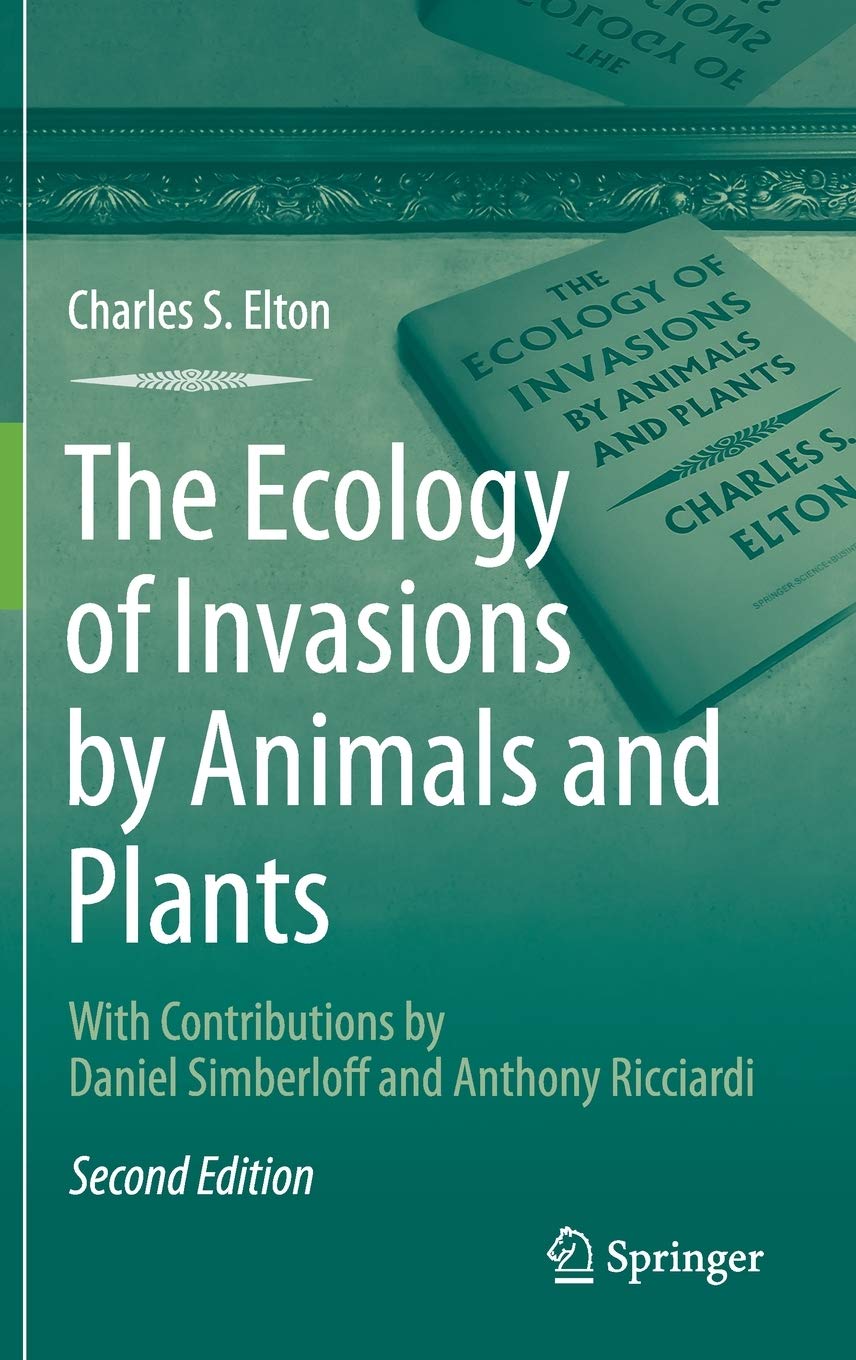 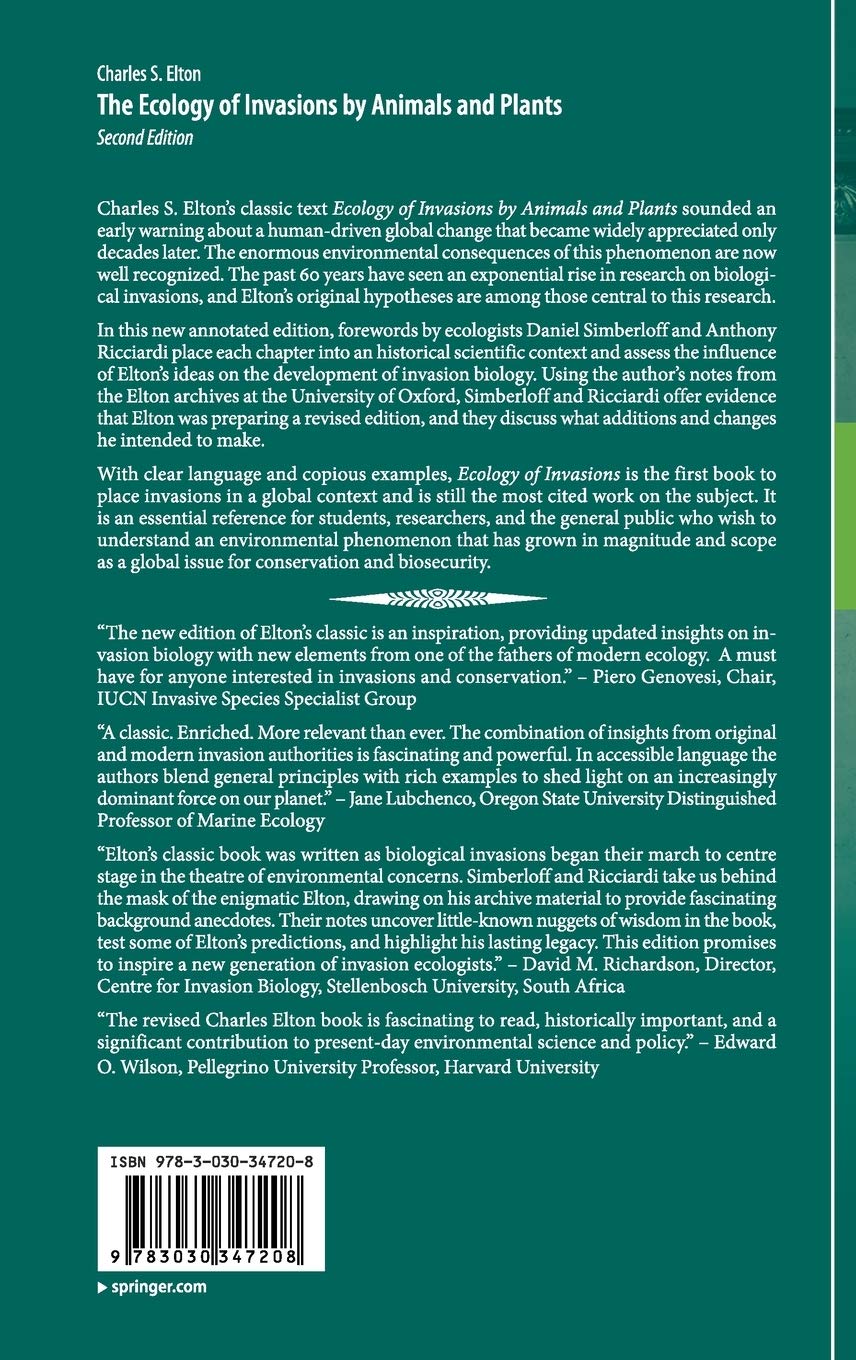

GLOBAL DETERMINANTS OF PREY NAIVETÉ TO EXOTIC
PREDATORS
Recently published: A new meta-analysis led by Andrea
Anton and colleagues tests hypotheses concerning prey
naiveté to alien predators. Among the findings: Prey
naiveté was most pronounced towards exotic predators
that did not have native congeneric relatives in the
recipient community. About 200 generations are needed
for native prey to acquire traits for antipredator
defense. This may explain observed declines in some
negative ecological impacts over time. Download the
paper here.
[June 2020]
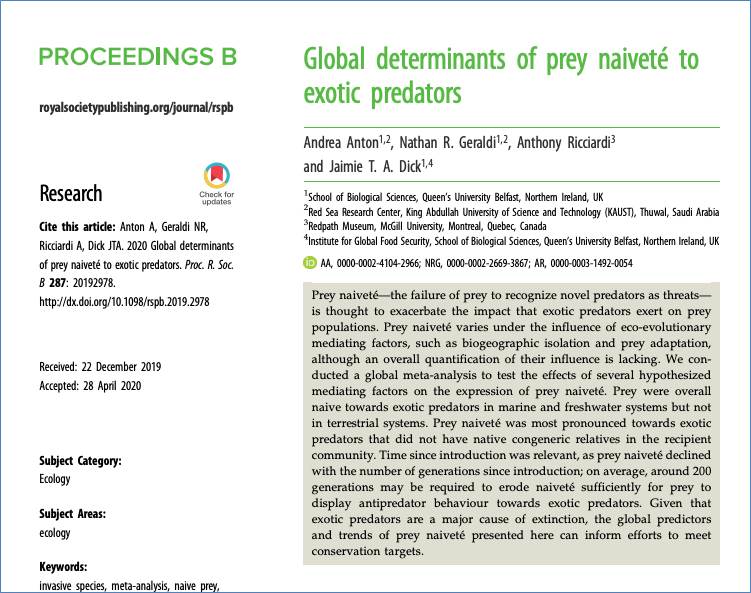

INVASION
SCIENCE AND THE GLOBAL SPREAD OF SARS-CoV-2
The global spread of the novel coronavirus SARS-CoV-2
(responsible for COVID19) is a biological invasion.
The virus is likely among the most rapidly spreading
invasive organisms ever documented. Stages of
population growth and geographic spread of infectious
diseases mirror those of invasive species.
Collaborations between biomedical researchers and
ecologists are vital to limiting future outbreaks. In
our new article in Trends in Ecology and Evolution, we
propose that invasion science offers a
cross-disciplinary platform for facilitating research
on emergent zoonotic diseases. A nice collaboration
with Martin Nuñez and Anibal Pauchard! Download the
paper here.
[May 2020]
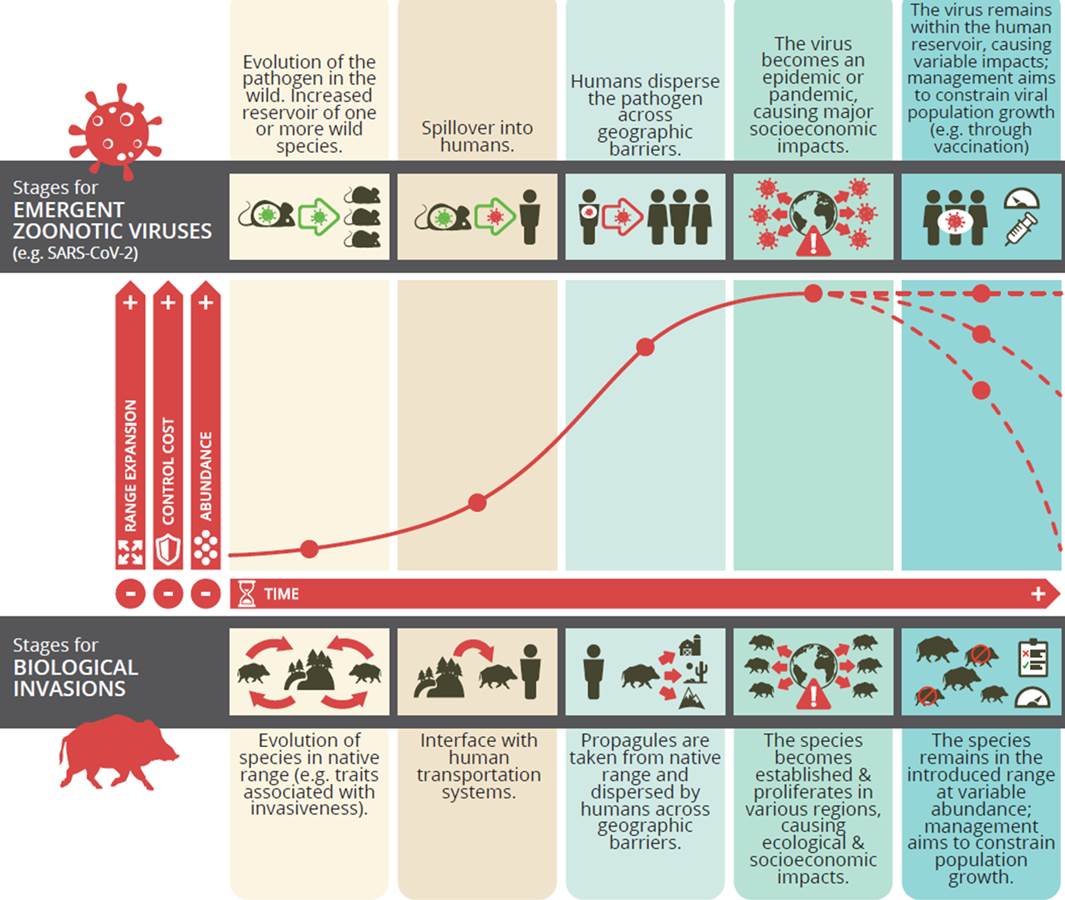

DISTRIBUTION,
ABUNDANCE, AND DIVERSITY OF MICROPLASTICS IN THE
UPPER ST. LAWRENCE RIVER
Recently published: MSc student Alex Crew led the
first study to demonstrate empirically which
environmental variables best predict the diversity,
abundance, and distribution of different forms of
microplastic particles in river sediments. To date,
only one previous study has reported on the abundance
of microplastics in the St. Lawrence River - work done
in our lab (Castañeda et al. 2014), which found large
polyethylene microbeads (400–2000 µm diameter) broadly
distributed in sediments across the river bed. Whereas
our previous investigation focused exclusively on the
occurrence and abundance of large microbeads, our new
study was designed to quantify diverse types of
microplastics in the river and to identify
environmental predictors. The mean total concentration
of microplastics we measured across the river bed is
among the highest recorded (top 25% of marine and
freshwater systems) in the world. We identified
sediment and land use characteristics as important
explanatory variables. Our methodology included
classification tools that should help researchers
identify microplastic types. Finally, we offer insight
into how extraction and identification methods could
be standardized for large monitoring programs. You can
download the paper here.
[May 2020]
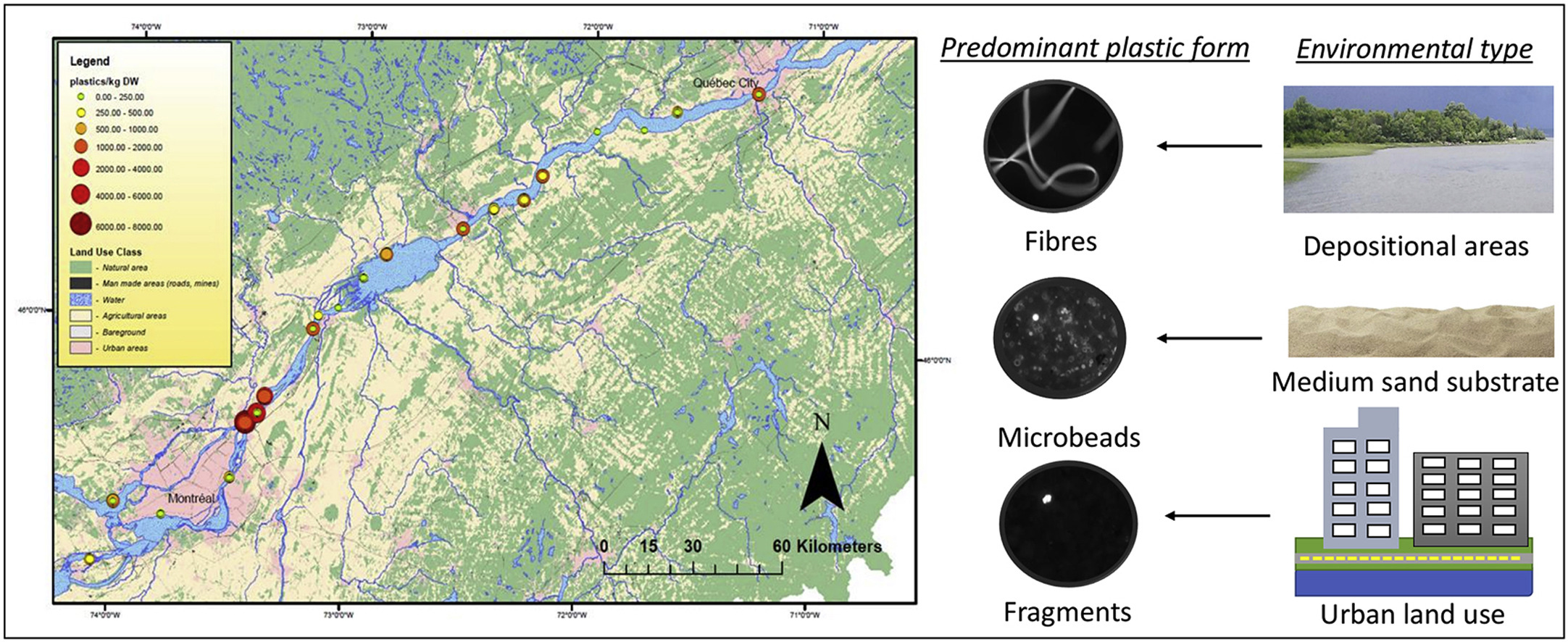

VARIATION
IN FEEDING PERFORMANCE ACROSS CONSPECIFIC
POPULATIONS OF CRAYFISH
Former MSc student Jaime Grimm led a large-scale,
multi-population comparison of functional responses of
the American spinycheek crayfish, Faxonius limosus
— a species with an extensive invasion history in
eastern North America and Europe. She measured
functional responses on individuals from six
geographically disparate populations of F. limosus
in its native and invaded ranges on two continents.
The study revealed inter-population differences in
both the maximum feeding rate and functional response
type that could not be explained by the biogeographic
origin of the population nor by time since the
invasion. We hypothesized that these differences might
reflect the composition of the source community of
these populations. Our experiments found that feeding
rate of F. limosus, but not its congener F.
virilis, was suppressed in the presence of
heterospecific and conspecific competitors,
demonstrating how the per capita effects of these
species can differ across biotic contexts. You can
download the paper here.
[March 2020]
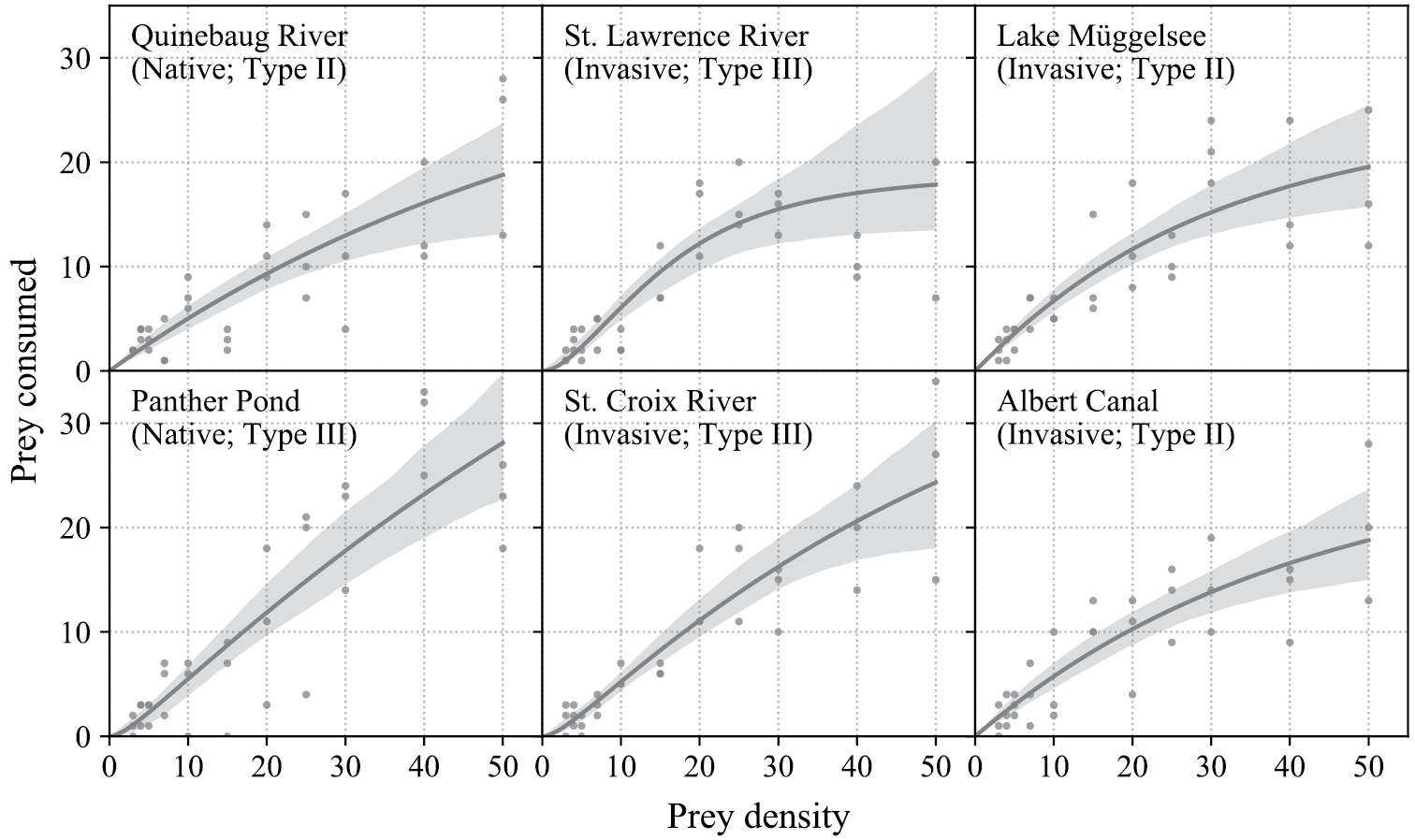 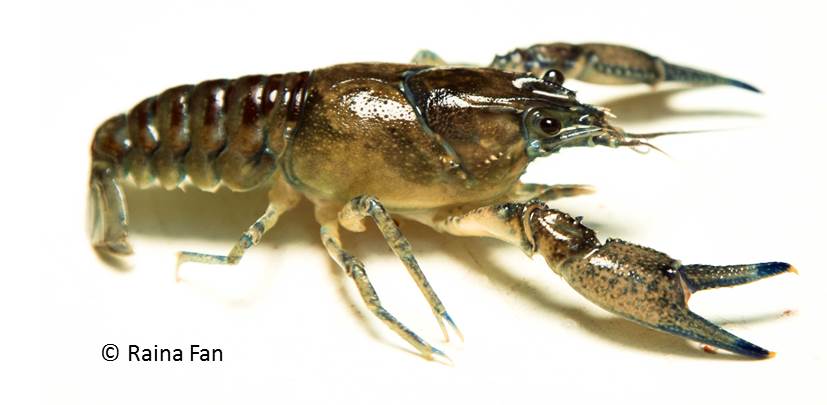

CONSEQUENCES
OF CONSUMER ORIGIN AND OMNIVORY ON STABILITY IN
EXPERIMENTAL FOOD WEB MODULES
In this novel experiment by PhD students Katie
Pagnucco and Monica Granados, we surgically altered
crayfish to create predators to compare with
conspecific omnivores! We constructed
crayfish–snail–algae food web modules using four
congeneric species of crayfish (Faxonius spp.),
two from native populations (Faxonius propinquus
and Faxonius virilis) and two from non‐native
populations (Faxonius limosus and Faxonius
rusticus). We surgically manipulated crayfish
feeding structures to create omnivores and predators
of the same species and used them in to construct
omnivore and predator food web modules. We compared
the temporal stability of these modules using measures
of the coefficient of variation of the basal resource:
benthic algae. Consistent with theory, food web
modules with omnivory had the lowest coefficient of
variation. However, contrary to prediction, we did not
find consistently higher coefficients of variation in
modules with non‐native species. Rather, across
species, we found the lowest coefficient of variation
in modules with one of the non‐native species (F.
rusticus) and one native species (F. virilis),
owing to stronger interactions between these crayfish
species and their snail and algal food resources. Our
results suggest that omnivory is indeed stabilizing
and that very weak interactions or very low attack
rates of the consumer on the basal resource can be
unstable. We conclude that omnivores may have
different impacts than predators when introduced into
a novel ecosystem. You can download the paper here.
[August 2019]
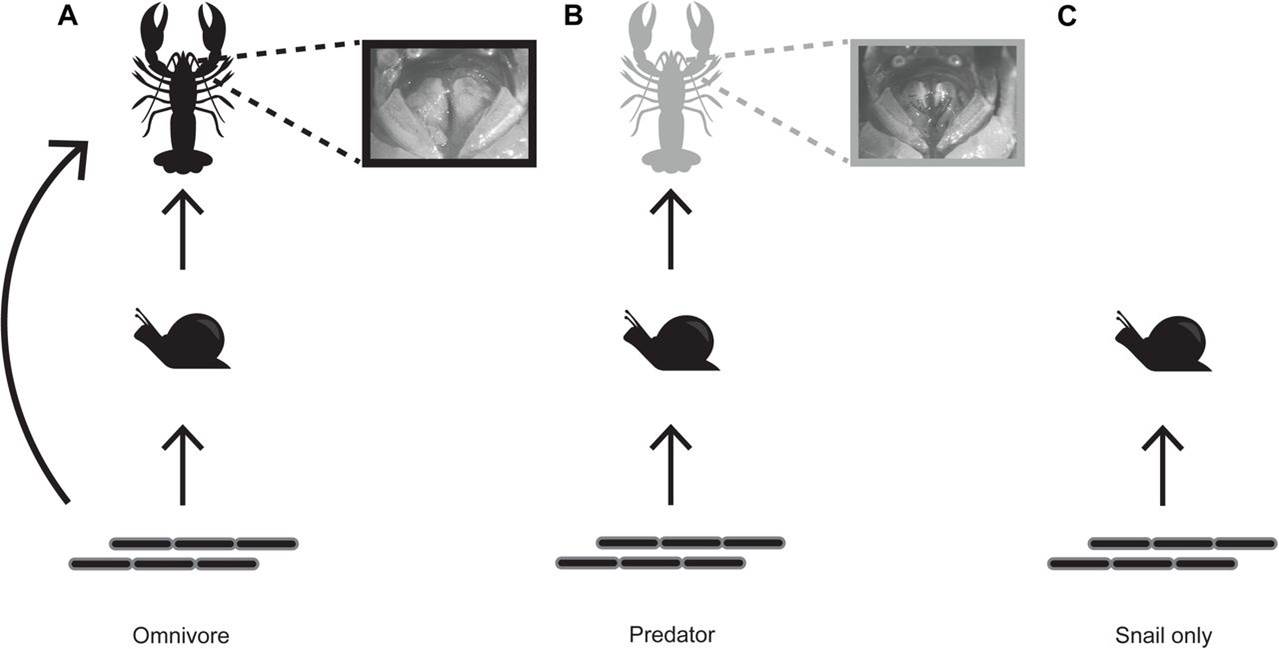

AN
EXTRAORDINARY MEETING ON THE FUTURE OF INVASION
ECOLOGY
David Aldridge and I organized an exciting workshop
held at the University of Cambridge in September, in
which several prominent ecologists convened to discuss
the future of invasion ecology. We conducted a horizon
scan of emerging issues likely to affect how invasions
are studied and managed over the next two decades. Our
efforts were guided by Bill Sutherland, a pioneer of
the application of horizon scanning techniques to
ecology and conservation biology. It was one of the
most creative and productive meetings that I have ever
attended, a feeling expressed by many of the
participants. Our results (recently submitted for
publication) identified new research directions and
policy initiatives, and point to an expanding
interdisciplinary role for invasion ecology in the
near future. We expect three insightful papers to
develop from this workshop.[October 2016]
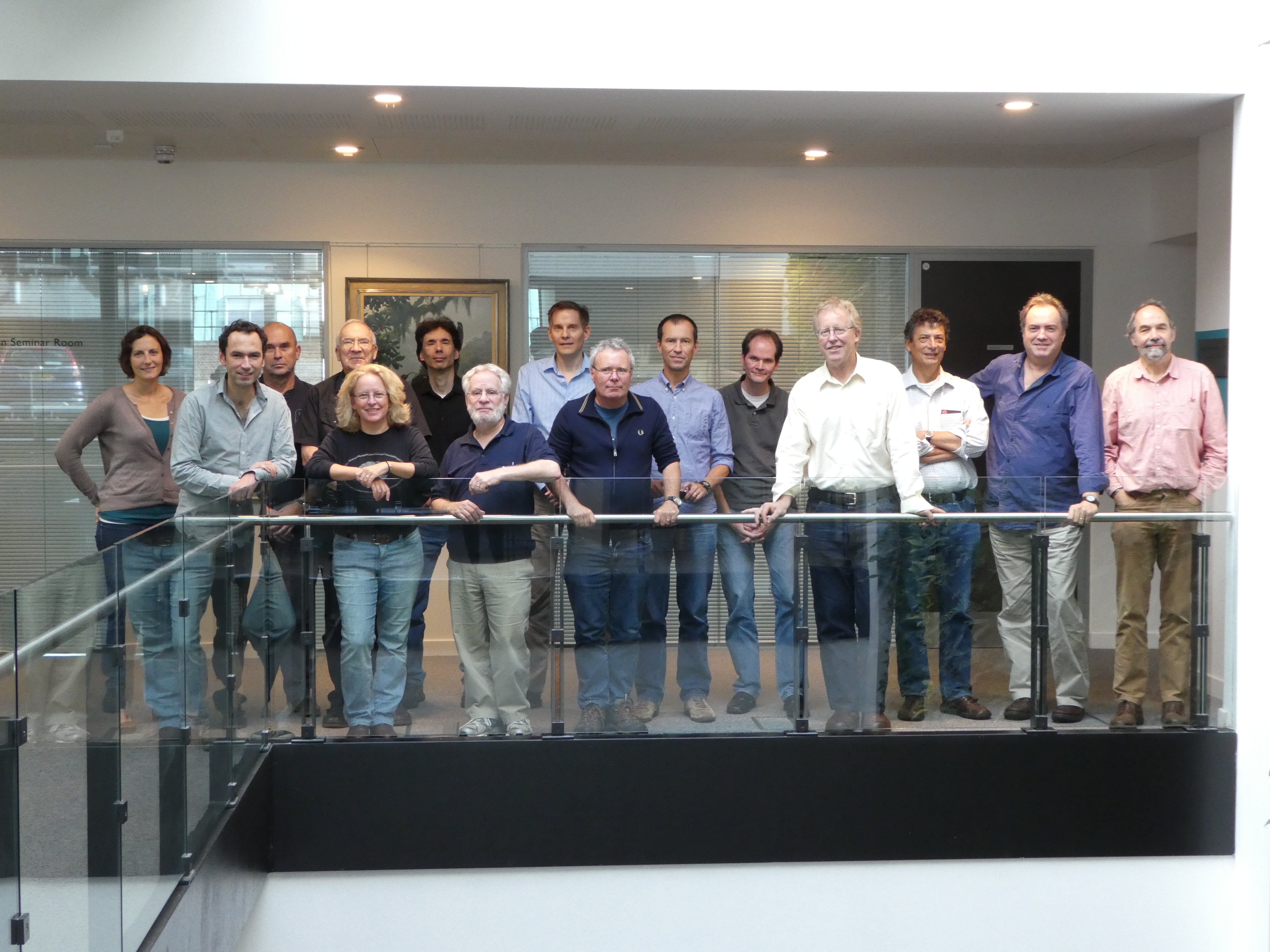
The Cambridge team, in the David Attenborough
Building: Josie Iacarella, David Aldridge, Petr
Pysek,
Dan Simberloff, Julie Lockwood, Tony Ricciardi, Jim
Carlton, Phil Hulme, David Wardle, Tim Blackburn,
Jonathan Jeschke, Sandy Liebhold, Greg Ruiz, Dave
Richardson, and Bill Sutherland.
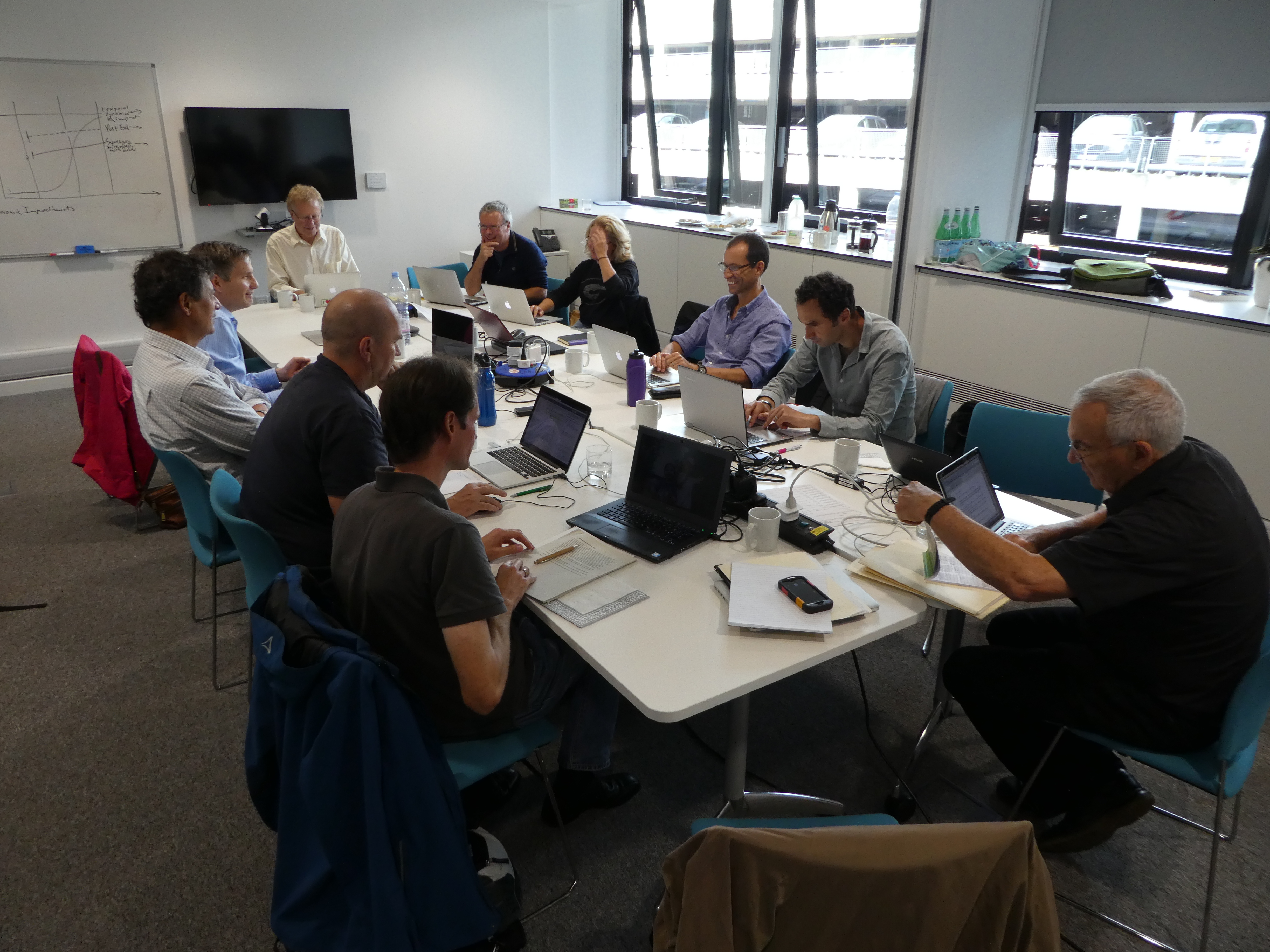
The team hard at work.

Discussions continued during coffee breaks.

IT'S
WONDERFUL TO BE ON SABBATICAL
In 2016, I will be a Visiting Research Fellow at
Queens University Belfast, where my colleague Prof.
Jaimie T.A. Dick has done splendid research on aquatic
invasive species – most notably the use of comparative
functional responses to explain and predict impacts. I
will visit his lab to pursue some new projects that
will further develop this approach as a risk
assessment method. I am also proud to have become a
Research Associate with the Centre of
Excellence in Invasion Biology (CIB) in
Stellenbosch, South Africa. For over a decade, the CIB
has been the world’s leading research hub for the
science of invasions. I have participate in several of
its workshops and symposia (including one in 2008 that
commemorated the 50th anniversary of Charles Elton’s
influential monograph The Ecology of Invasions by
Animals and Plants), and have never ceased to be
impressed by the diversity of expertise amongst their
core membership, the breadth of projects undertaken,
and the energy and commitment of their students. I was
honoured to give a keynote talk at the CIB’s Annual
Research Meeting in November 2015, and will be working
with Prof. Dave Richardson (the Director of the CIB)
and other colleagues on a major conceptual paper
stemming from that presentation. [February 2016]

ANOTHER
PHD GRADUATE LEAVES THE RICCIARDI LAB
On November 30, Katie Pagnucco expertly defended her
dissertation, which examined direct and indirect
impacts of non-native freshwater fishes and crayfishes
on recipient food webs. She used some very clever
methods, including novel experimental approaches, to
tease apart the relative importance of variables that
contribute to context-dependent variation in invader
impact. Katie has begun a postdoc in Prof. Bea
Beisner's lab at UQAM, while simultaneously working as
a lecturer in the McGill School of Environment.
Congratulations, Dr. Pagnucco! [November 2015]

Katie, with her family and friends, after the
successful thesis defense.

WE ARE
RECRUITING NEW GRAD STUDENTS!
Three funded student positions are available. We are
seeking a MSc student to study predator-prey
interactions involving an invasive freshwater fish
(Round Goby) and molluscs in the St. Lawrence River
(see here
for more information). We are also seeking MSc and PhD
students to study the diversity and impacts of
microplastic pollution in the St. Lawrence River and
in Great Lakes tributaries (see here for more
information). The closing date for applications is
December 15.[December 2015]

A
NEWLY MINTED PHD IS LEAVING THE RICCIARDI LAB
Josie Iacarella successfully defended her doctoral
dissertation on Monday June 1, 2015, less than four
years after joining our lab. Josie’s research
investigated how the ecological impacts of invasive
species vary across space and time. She used a
combination of approaches (field mesocosm experiments,
reciprocal transplants, lab experiments, and
meta-analysis) on different taxa (fish, crustaceans,
plants) to examine abiotic and biotic mediators of
impact. Her work developed and tested two new
hypotheses and revealed intriguing patterns that will
certainly fuel future research. In the autumn she will
be taking up a postdoctoral position at University of
Victoria. Congratulations, Dr. Iacarella! [June
2015]
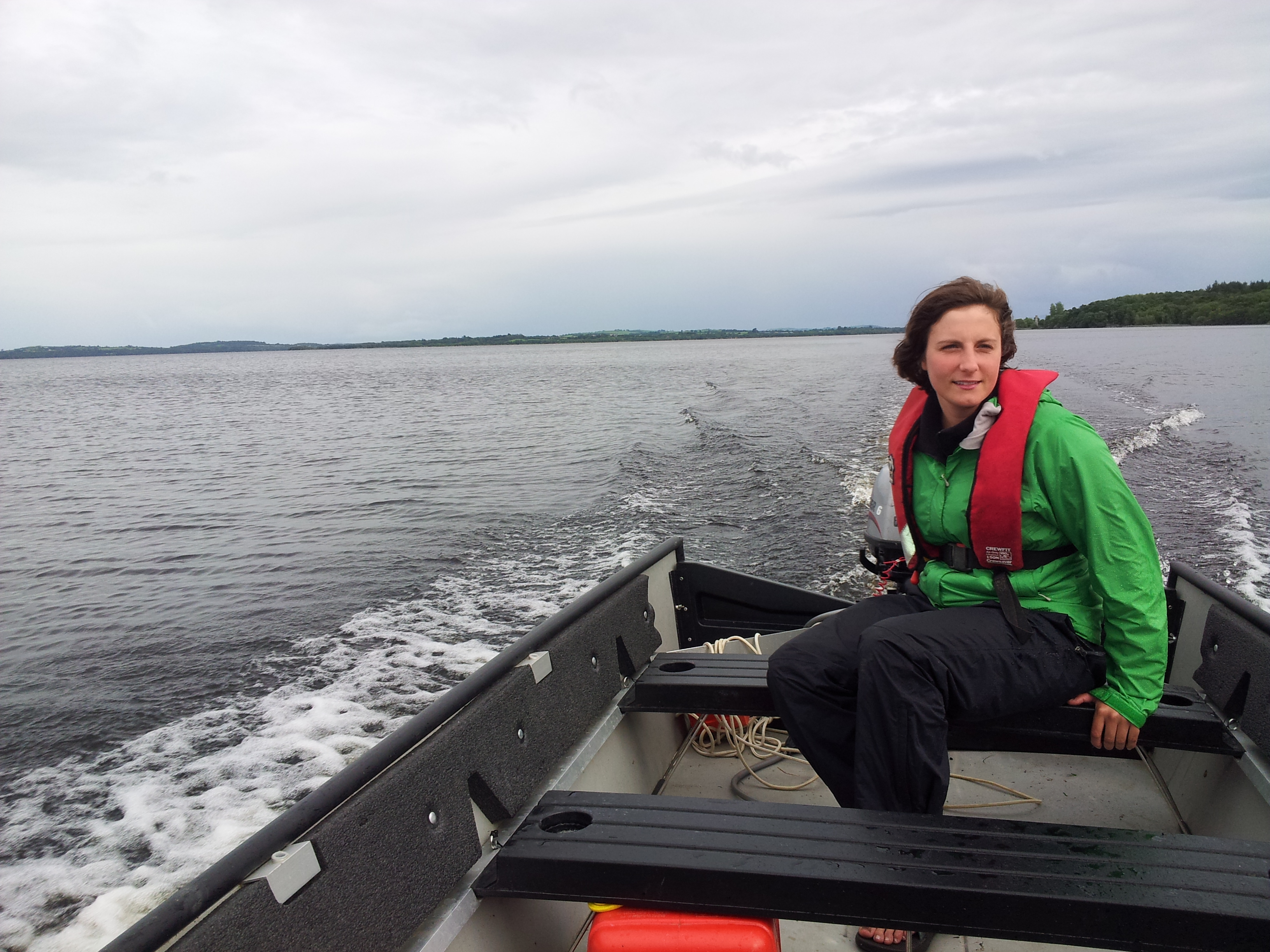
The intrepid Dr. Iacarella on her way to a field
site in the U.K.

OUR
MICROPLASTICS RESEARCH HIGHLIGHTED IN THE MEDIA
Our ongoing work on microplastic pollution in St.
Lawrence River sediments was the subject of a recent
broadcast of Le Code Chastenay - a televised
documentary series that discusses innovative
scientific research in Quebec and its implications for
society. It features two student who led the field
team that discovered the microplastics: Rowshyra
Castañeda (former McGill student, now a PhD candidate
at the University of Toronto) and Sunci Avlijas (one
of our current PhD students). You can watch the
broadcast here.
[March 2015].
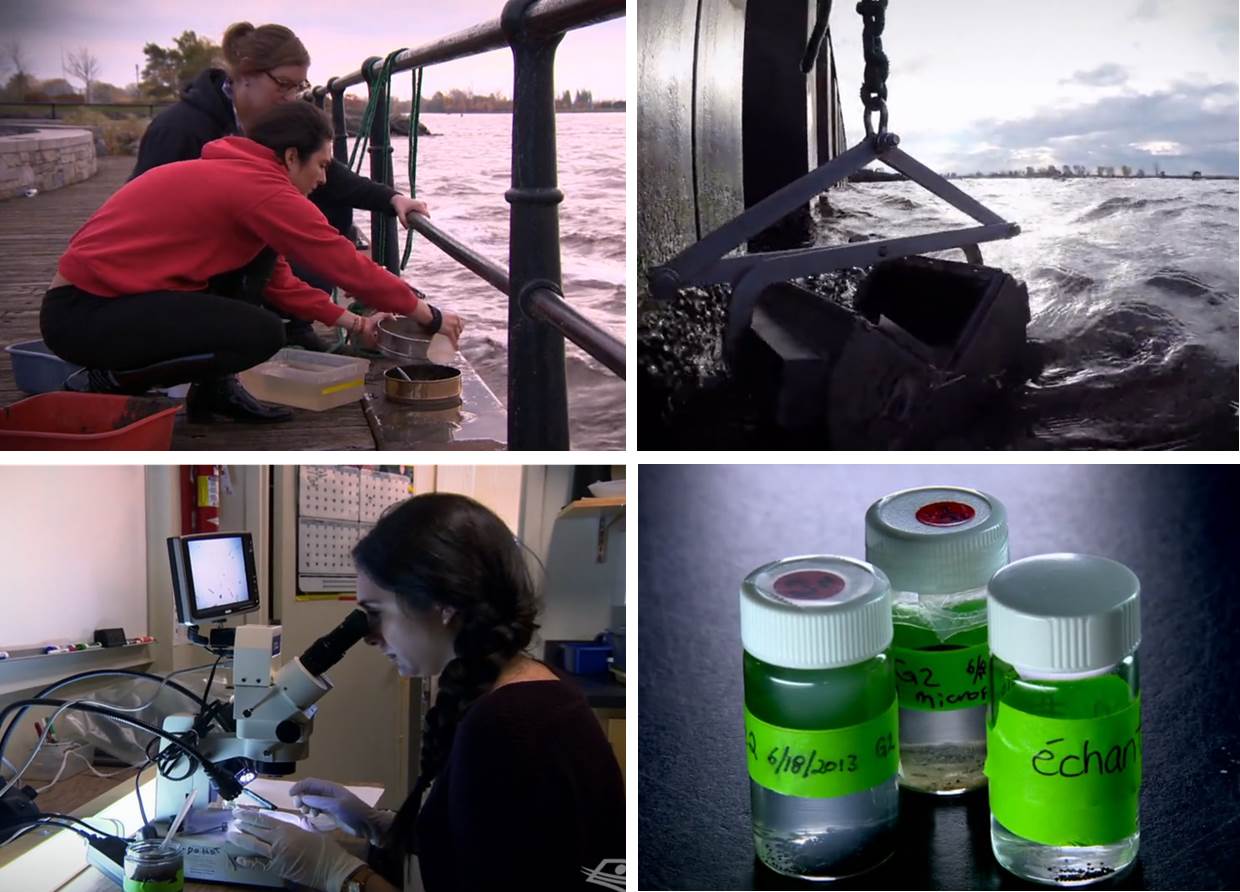

FUTURE SPECIES INVASIONS IN THE GREAT LAKES
The Great Lakes are the most invaded freshwater
ecosystem in the world. We have examined the history
of invasions in the basin, and demonstrated a strong
correlation between vector activity and the occurrence
of non-native species (Ricciardi & MacIsaac 2000,
Ricciardi 2001, Ricciardi 2006). In spite of
increasing efforts over the past two decades to halt
the influx of invaders, and the apparent successful
implementation of ballast water regulation in the
mid-2000s, the Great Lakes remain vulnerable to future
disruptions. New threats are emerging because of risks
associated with trade in live organisms and climate
change; invasion risks are dynamic and management
responses must evolve to cope with them. In a new
analysis, we present three future scenarios
(optimistic, pessimistic and status quo) that depend
upon the development and effectiveness of regulations
aimed at blocking current means of entry for invasive
species. The paper will be published in a special
issue of the Journal
of Great Lakes Research. See the
McGill press release
here. [February 2015].
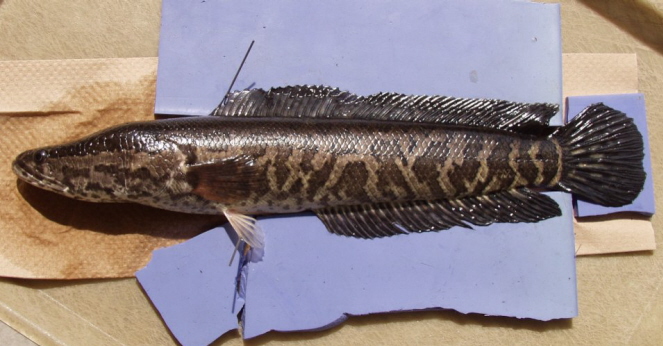
The northern snakehead (Channa argus) is a
potential future invader of the Great Lakes. Photo
by USGS.

MICROPLASTIC POLLUTION DISCOVERED IN ST. LAWRENCE
RIVER SEDIMENTS
Students from my lab discovered microplastics (in the
form of polyethylene ‘microbeads’, <2 mm diameter)
widely distributed across the bottom of the St.
Lawrence River, the first time such pollutants have
been found in freshwater sediments. The microbeads
likely originate from cosmetics (e.g. exfoliants) and
industrial applications. Microplastics are a global
contaminant in the world’s oceans, but have only
recently been detected in the surface waters of lakes
and rivers. At some locations, we measured thousands
of microbeads per liter of sediment (and hundreds of
thousands per square meter), a magnitude that rivals
the world’s most contaminated ocean sediments.
Contrary to the assumption that floating microplastics
are flushed through rivers to the sea, our study shows
that rivers can act as a sink for this pollution. The
article will be published in the Canadian
Journal of Fisheries and Aquatic Sciences.
September 2014].
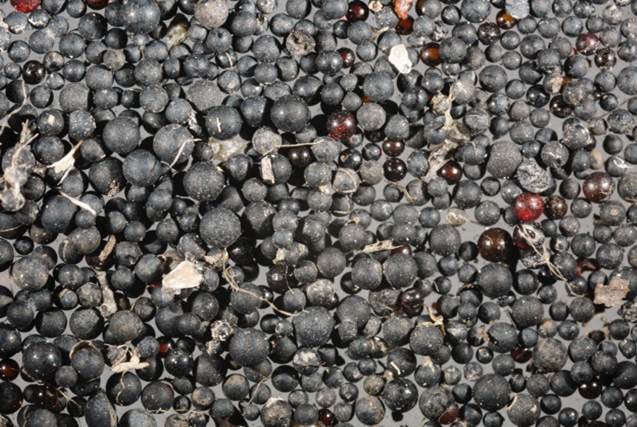
Microbeads collected from St. Lawrence River
sediments, summer 2013.

A
NOVEL SCHEME TO CLASSIFY NON-NATIVE SPECIES THREATS
In July 2013, I was fortunate to join several European
and South African colleagues in Leipzig for an invited
workshop that examined the science and management of
impacts of non-native species. The creativity and
energy within that gathering was abundant, and a
series of papers have begun to emerge from our
efforts. One of these, led by Tim Blackburn, outlines
a logical and flexible method for classifying invasion
threats according to the magnitude and mechanism of
their environmental impacts. The paper has appeared in
PLoS Biology
recently and is the focus of a review article in
Conservation. Another paper, led by
Jonathan Jeschke and appeared in Conservation
Biology, addresses the issue of
properly defining 'impact' for the
purposes of non-native species research and
risk assessment. [June 2014].


NON-NATIVE SPECIES ARE MORE LIKELY THAN NATIVES TO
BECOME PESTS
In recent years, there has been a rise in opinion
articles in which authors have claimed that non-native
species are no more likely than natives to cause
ecological or economic damage. Our lab has tested this
claim in a series of recent and ongoing studies. In an
analysis of data for freshwater plants and animals,
MSc graduate Ahdia Hassan found that non-native
species comprise the majority (60%) of aquatic pests
in North America and Europe, and are six times more
likely than native species to become a pest (i.e.
cause socioeconomic damage). Moreover, the pest status
of a species is dependent on the scale of its
introduction: species moved
between continents have a
greater likelihood than intra-continentally
transplanted species of being a pest. Our paper
has been published in the journal Frontiers
in Ecology and the Environment. [May
2014].

Some freshwater pest species in North America: (a)
The quagga mussel (Dreissena rostriformis
bugensis);(b) Water hyacinth (Eichhornia crassipes);
(c) Silver carp (Hypophthalmichthys molitrix), a
hazard to recreational boaters; and (d) the bryozoan
Plumatella rugosa, a native fouling pest, shown
encrusting a water pump. From Hassan & Ricciardi
(2014).

NOVEL
APPLICATIONS OF FUNCTIONAL RESPONSE ANALYSIS TO
INVASION ECOLOGY
Collaborations with Jaimie Dick's lab (Queen's
University Belfast) have involved multiple graduate
students working on both sides of the Atlantic and
have led to rapid progress in the use of functional
responses for understanding and predicting invasion
success and impact. Previous work in our lab by Dr Åsa
Kestrup (e.g. Kestrup
et al. 2011) and ongoing work by PhD
candidate Josie Iacarella have shown the value of this
approach in explaining context-dependent variation in
invader impact. Åsa used functional response
comparisons to shed light on asymmetrical intraguild
predation among native and non-native crustaceans,
whereas Josie is using this method to test novel
hypotheses - including the Environmental Matching
Hypothesis (Ricciardi et al. 2013 Ecol. Monogr.).
Now, PhD candidate Danny Barrios-O'Neill (supervised
by Jaimie Dick, in collaboration with me and Hugh
MacIsaac) has demonstrated its value in quantifying
and predicting the impact of invasive consumers within
an elegant multi-species experimental system. Danny
compared native and non-native mesopredators (mysid
shrimp) in the presence and absence of a higher
predator a stickleback), and showed that the native
mysid was more inhibited by the higher predator - and
thus had consumed fewer basal prey (cladocerans) than
the more bolder non-native mysid. His results recent
are published in the Journal
of Animal Ecology and is highlighted
in an "In focus" article
in the same issue. [April 2014].
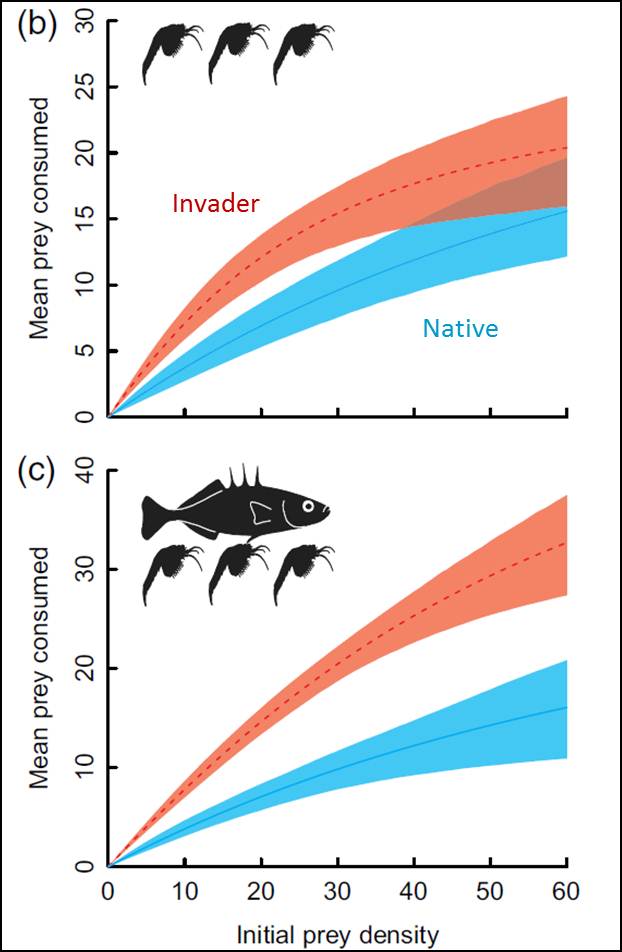
Functional responses of native mysids (in blue) and
invasive mysids (in red) alone (b) and in the
presence of a stickleback (c). Shaded areas are
bootstrapped 95% confidence intervals. After
O'Gorman (2014), adapted from Barrios-O'Neill et al.
(2014).

INVASIVE
ALIEN SPECIES IN EUROPE: KEY MANAGEMENT ISSUES
Last year, I had the privilege of participating in the
Freshwater Invasives – Networking for Strategy
(FINS) conference in Galway, Ireland, where managers,
academics, policy makers and international experts met
to collectively identify the key issues relating to
invasive alien species in Europe. These 10 key issues
were determined in a horizon scanning workshop, and
are relevant to invasion threats in terrestrial and
marine systems as well. Our findings have now
been published in the journal Management
of Biological Invasions.
Governmental support for this endeavour was strong;
the Irish Minister of Fisheries was in attendance. I
thank Joe Caffrey and Frances Lucy for inviting me to
take part in this important workshop. [April 2014].

A
COMPREHENSIVE RESPONSE TO CRITICS OF INVASION
SCIENCE
For the past decade, the science of biological
invasions (invasion ecology, invasion biology) has
been subject to frequent attacks by a small but vocal
minority of critics who claim that invasion impacts
are exaggerated, that the research is biased, that
non-native species are no more likely than natives to
cause ecological or economic disruptions, and that the
native/non-native dichotomy has no scientific
merit. Although these criticisms have been
refuted, they are often repeated and given media
attention. My colleague Dave Richardson and I present
a comprehensive summary of these misleading
criticisms, and referenced rebuttals to each of them,
in an editorial
published in the latest issue of Diversity and
Distributions [November 2013].

TOWARD
A SYNTHESIS OF NON-NATIVE SPECIES IMPACTS
There has been a recent surge in top-tier journal
articles that aim to synthesize theories of invasion
biology, but each of these articles focuses primarily
on the process of colonization rather than on the
ecological impacts of non-native species. In a
new paper
published in Ecological Monographs, my
colleagues (Martha Hoopes, Michael Marchetti and Julie
Lockwood) and I identify and assess 19 testable
hypotheses that explain mechanistically the impacts of
non-native plants, animals, or both. Our review also
reveals taxonomic biases in the empirical testing of
many of these hypotheses. Certain hypotheses are
broad in scope and suggest key elements of a general
theoretical framework for understanding and predicting
impact. [July 2013].
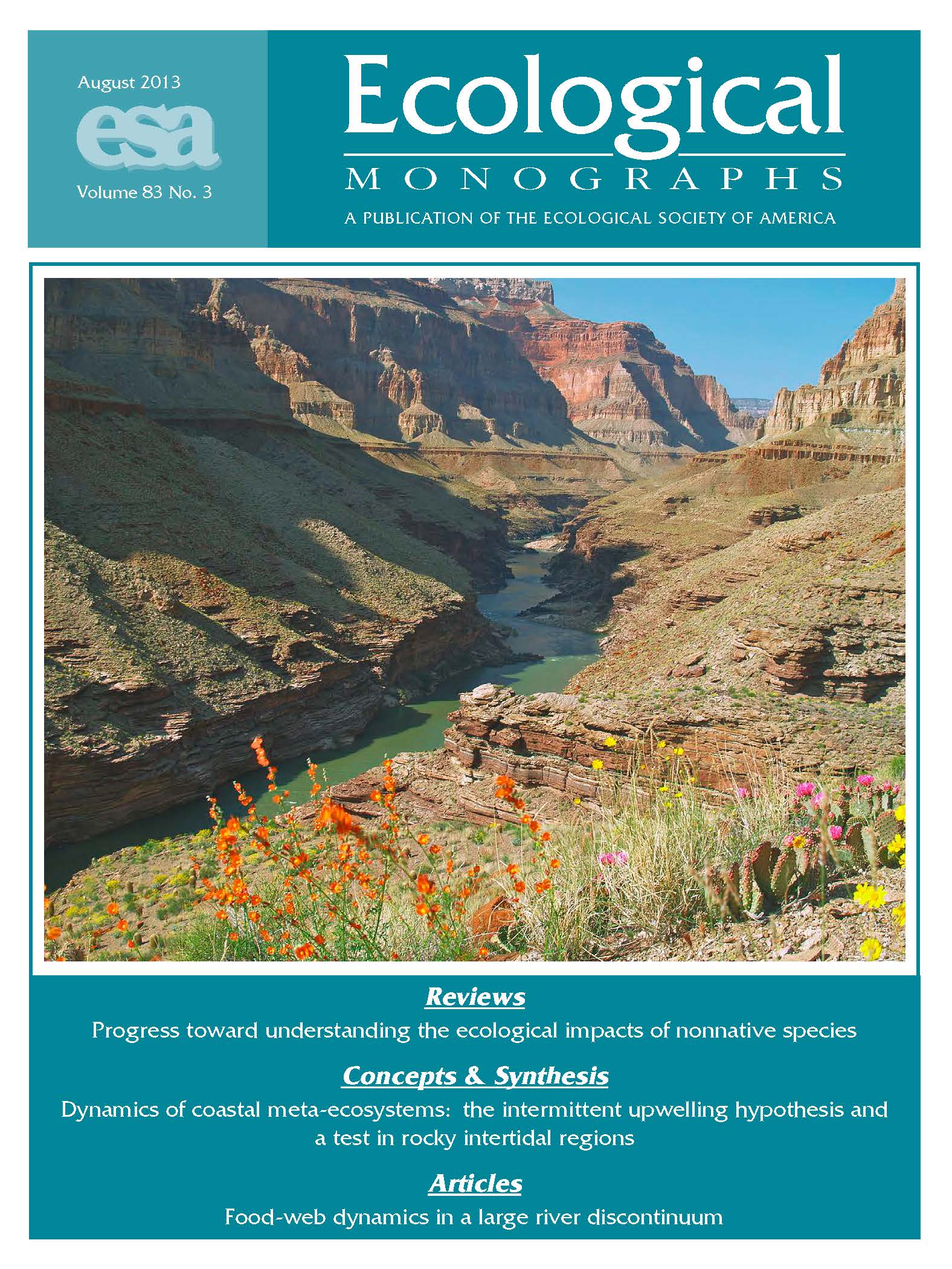

KUDOS
TO RICCIARDI LAB STUDENTS
Congratulations to four students who graduated from
McGill this spring: Lisa Jones (PhD), Sunci Avlijas
(MSc), Rowshyra Castaneda (MSc), and Andrea Reid
(MSc). Each of these graduates has a bright future
ahead of them.
Several students from our lab presented their research
at the International Conference on Aquatic Invasive
Species, held at Niagara Falls in April, and at the
annual general meeting of the Canadian Aquatic
Invasive Species Network (CAISN), held at Kananaskis
in May. At the Kananaskis meeting, which was attended
by over thirty CAISN students and postdocs, MSc
candidate Ahdia Hassan received an award (2nd place)
for an excellent presentation about her work comparing
the socioeconomic impacts of native versus non-native
freshwater species. MSc candidate Jordan
Ouellette-Plante's presentation on phenotypic
plasticity in dreissenid mussels also received
recognition. A total of 13 student presentations were
made by our lab at these two conferences.
Finally, former MSc student Rebekah Kipp's article
concerning the impacts of the round goby on molluscs
in the St. Lawrence River has been chosen as the
Elsevier Best Paper by a Young Scientist for the 2012
edition of the Journal of Great Lakes Research.
[May 2013].
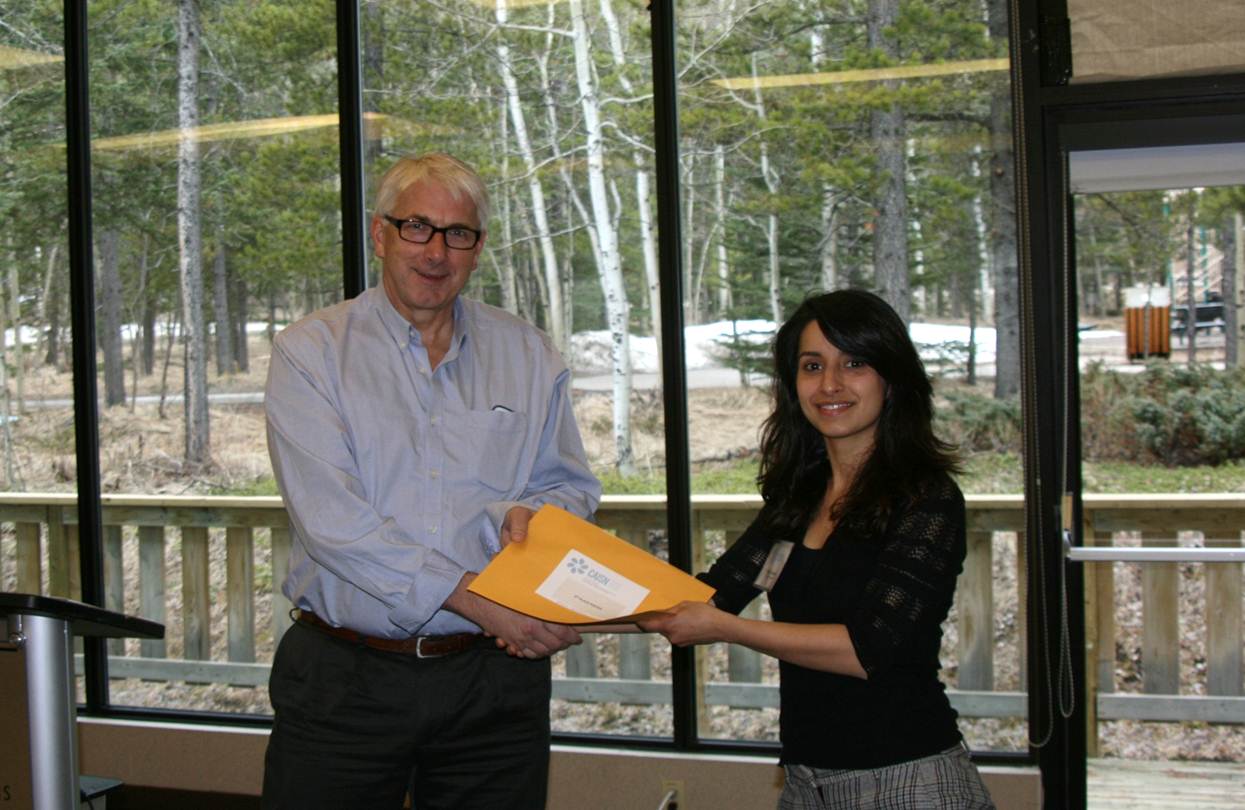
Ahdia Hassan accepting her award from Dr. Hugh
MacIsaac, Director of CAISN. Photo by Matthew Daley.

ALIEN
CONSUMERS INFLICT GREATER DAMAGE TO PREY POPULATIONS
THAN DO NATIVES
It has been claimed (Davis et al. 2011) that
non-native species are no more likely to cause
ecological disruptions than are native species.
Using data from a broad range of ecosystems, Esteban
Paolucci, Hugh MacIsaac and I have conducted a
meta-analysis that found that alien consumers
(predators and herbivores) cause more than twice the
amount of damage to native prey populations than do
native consumers. Moreover, compared with native
consumers, alien consumers are associated with more
negative and fewer positive effects on prey
populations. This disproportionate impact might be a
consequence of prey naïveté to alien consumers. Our
results counter the assertion that the biogeographic
origin of species has no bearing on their ecological
impact. The paper
appears in the journal Diversity and Distributions
[February 2013].
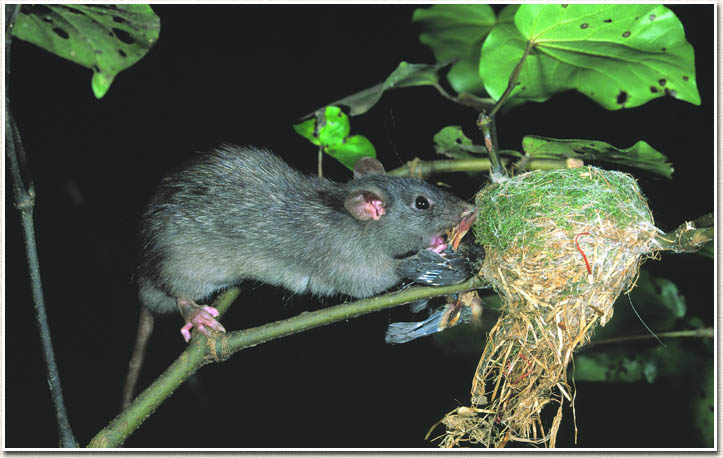
Example of an alien predator at work: a Eurasian
black rat attacking chicks in a fantail bird nest in
New Zealand. Photo courtesy of Nga Manu Images.

ANOTHER
NEW PHD LEAVES THE RICCIARDI LAB
Congratulations to Lisa Jones for successfully
defending her doctoral dissertation on Tuesday October
30, 2012. Lisa's thesis examined the phenomenon
of exotic species replacement, specifically the shift
in dominance between zebra mussels and quagga mussels
in the St. Lawrence River. Her field experiments
provided unique insight into the abiotic factors and
species trait differences that mediate these dominance
shifts. Her work was featured in the documentary film
Invasive
Species by the American Museum of Natural
History. We can expect a series of publications of her
research findings to appear in the coming months. She
has currently doing postdoctoral work as a Visiting
Fellow at Fisheries and Oceans Canada.
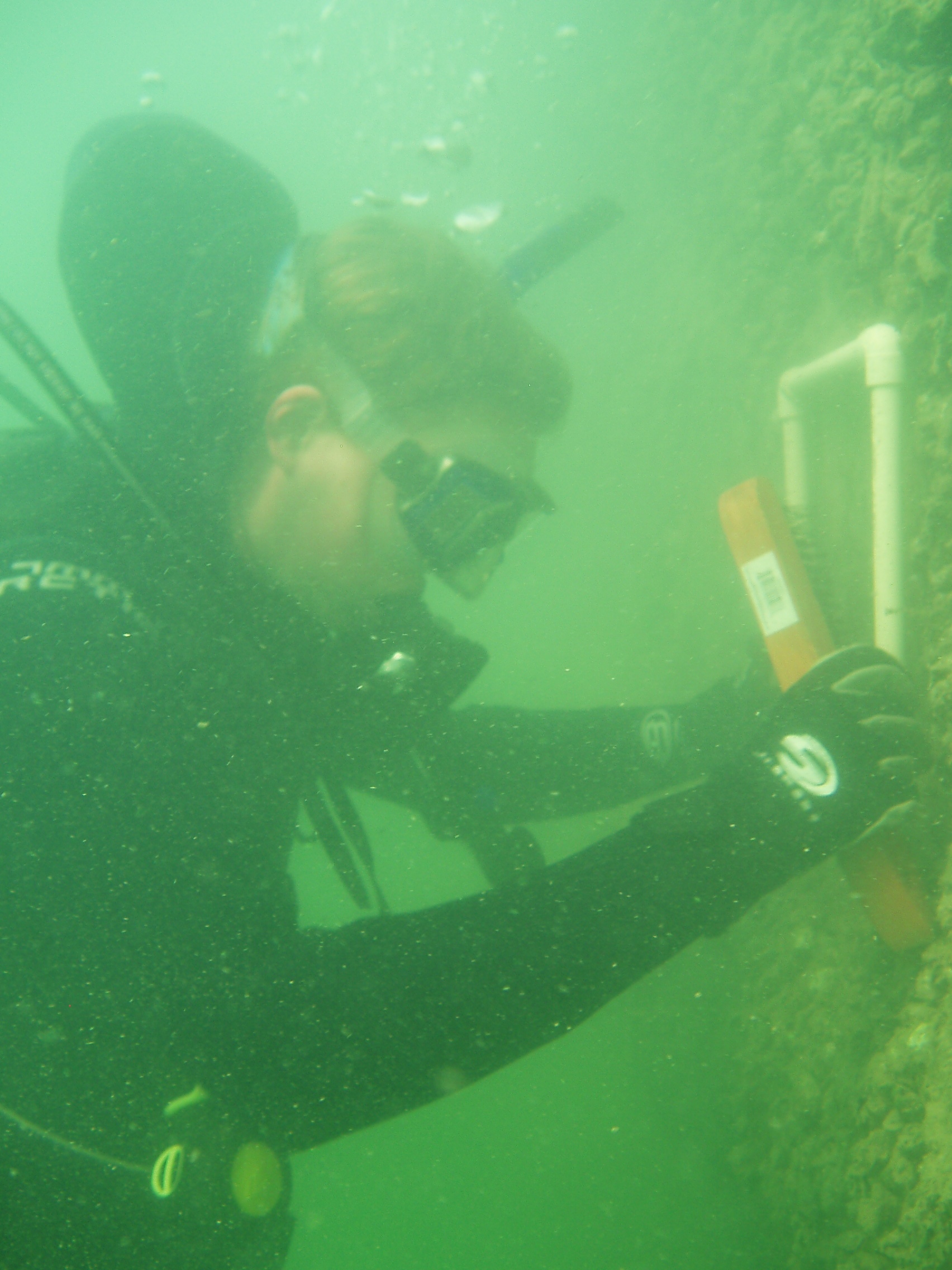
Dr. Jones examines an invasive mussel population in
the Soulanges Canal. Photo by Å. Kestrup.

LAKE
VICTORIA RESEARCH FEATURED IN THE NEW YORK TIMES
Andrea Reid, MSc candidate co-supervised by me and Dr.
Lauren Chapman, recently presented the results of her
work at a student conference held at the American
Museum of Natural History. A once hyper-diverse
assemblage of cichlid fishes was decimated in Lake
Victoria, largely as a result of predation by the
introduced Nile perch. Working in Lake Nabugabo, a
satellite of Lake Victoria, Andrea showed that several
species escaped this fate by using the edges of
wetlands as refugia. Her study, which will be
published in the journal Aquatic
Conservation, has been featured in a
New
York Times article [October 2012].
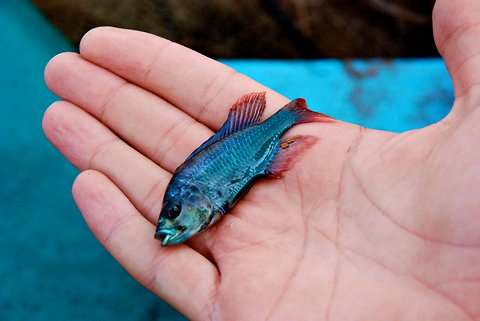
Photo of a cichlid by Andrea Reid.

A
NOVEL METHOD OF FORECASTING INVASION IMPACTS
We have been collaborating with Prof. Jaimie Dick
(Queen’s University Belfast) to test an innovative
method for assessing the risk posed by non-native
predators to their invaded communities. The method
involves a comparative analysis of the predator’s
functional response – i.e. the relationship between
its predation rate and prey density. If harmful
invaders display consistently greater functional
responses than closely-related native species, then
the impacts of new invaders may be predictable.
For example, we have found that the invasive
freshwater shrimp Hemimysis anomala has
functional responses towards prey species that are
consistently higher than those of native shrimp
species, both in Ireland and Canada. Moreover, the
prey species that are associated with the greatest
differential functional responses in the lab are the
same ones that are most impacted by Hemimysis
in the field (see our recent paper in Biological
Invasions). Students in both our
labs are testing this methodology using a broad range
of taxa, in a concerted effort to determine the extent
to which functional responses will allow us to predict
the population-level impacts of invaders [September
2012].
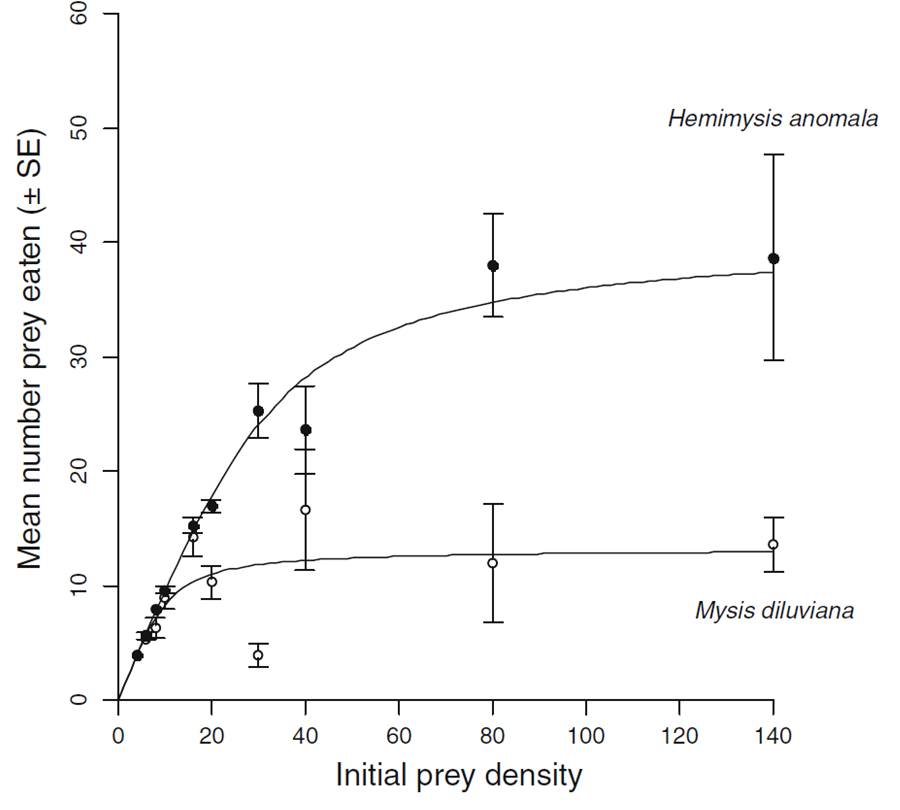
Functional responses of the invasive mysid shrimp
Hemimysis anomala and the native Mysis
diluviana feeding on cladocerans in a 12-hr
laboratory trial.

SPEAKING
TO THE HOUSE OF COMMONS STANDING COMMITTEE ON
FISHERIES
On April 25, I gave evidence
to the House of Commons Standing Committee on
Fisheries concerning the threat of invasive species to
native fish populations in the Great Lakes. In my
statement, I emphasized the role of live trade as an
unregulated series of vectors (e.g. involving live
bait, ornamental plants, aquarium pets, and species
sold for human consumption) that deliver thousands of
aquatic species into Canada each year. Unpublished
work by my students suggests that a non-negligible
proportion of these species can become established and
exert negative impacts in Canadian lakes and rivers.
Some of these species (e.g. Asian carp) are sold in
fish markets in major Canadian cities. [April 2012].
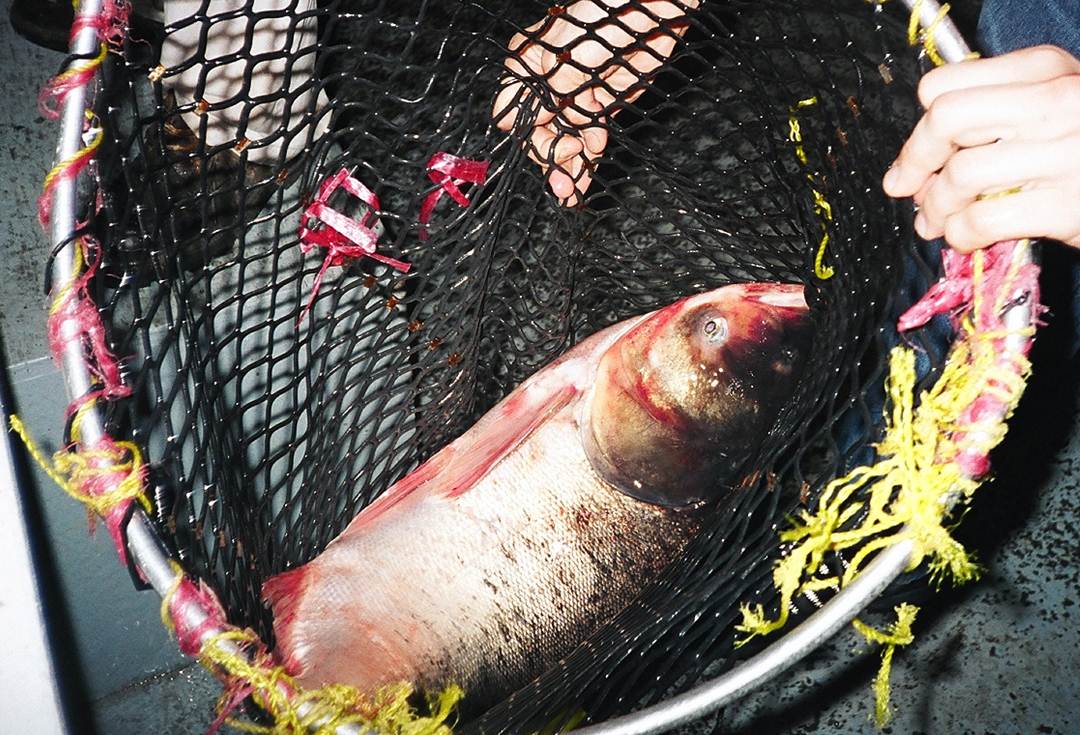
Asian bighead carp sold alive at a fish market in
Montreal. Photo by A. Ricciardi.

CAN WE
PREDICT THE IMPACTS OF THE BLOODY RED MYSID IN THE
GREAT LAKES-ST. LAWRENCE RIVER SYSTEM?
A Ponto-Caspian shrimp, the 'bloody red mysid' (Hemimysis
anomala), has rapidly colonized the lower Great
Lakes and the St. Lawrence River in recent years,
prompting concern over the potential consequences of
this invasion to native communities and food webs. To
forecast these consequences, we reviewed the impacts
of invasive freshwater mysids worldwide. Surprisingly
few impact studies exist for H. anomala, but
data from invaded Dutch reservoirs suggest that it can
depress zooplankton populations. The impact histories
of other freshwater mysids (Mysis spp.) provide
potentially valuable predictive information for H.
anomala. Mysids have been introduced into many
lakes in the United States and Scandinavia, where they
have frequently caused declines in the abundance of
zooplankton - especially cladocerans. Some of these
declines were drastic enough to cause a reduction in
the abundance and growth of pelagic fishes. It is not
clear whether H. anomala will have similarly
strong effects, but it can achieve higher densities
locally and invade a broader range of aquatic habitats
than other mysids. A major question is whether
planktivorous fishes can regulate mysid populations
and limit their impact on Great Lakes' food webs.
Nonetheless, predation on H. anomala could
increase the biomagnification of contaminants in
fishes. See our article in the Journal of
Great Lakes Research [February
2012].
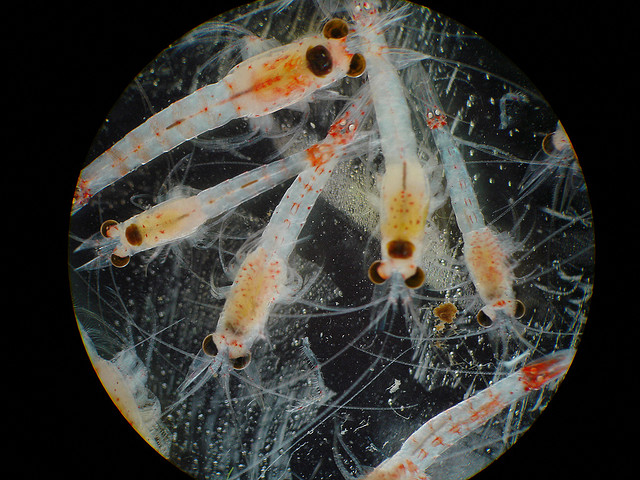
Photo of bloody red mysids by S. Pothoven
(NOAA/GLERL).

IMPACTS
OF ROUND GOBY INVASION IN THE ST. LAWRENCE RIVER
The Eurasian round goby (Neogobius melanostomus)
has spread from the Great Lakes into the St. Lawrence
River, where it has become increasingly abundant in
recent years. Studies by Rebekah Kipp (MSc, 2010) and
former NSERC USRA students Issac Hébert and Myriam
Lacharité have revealed the potential ecosystem impact
of this dominant benthivorous predator. Stomach
content analysis showed that gastropods and certain
insect larvae were a preferred prey item, whereas
zebra and quagga mussels were generally avoided by
gobies in the river. A concomitant field survey showed
that the biomass, diversity and median body size of
gastropods were negatively correlated with goby
density across all sites, and declined at sites
sampled before and after invasion. Contrary to studies
in the Great Lakes, there were no consistent effects
of goby density on the size structure of zebra and
quagga mussels in the river, although gobies exhibited
an ontogenetic diet shift toward mussels. Benthic
algal biomass increased with goby density across
sites, suggesting a trophic cascade driven by the
impacts of gobies on gastropods and other algal
grazers. See our papers in the Canadian
Journal of Fisheries and Aquatic Sciences
and the Journal of
Great Lakes Research. [February
2012].
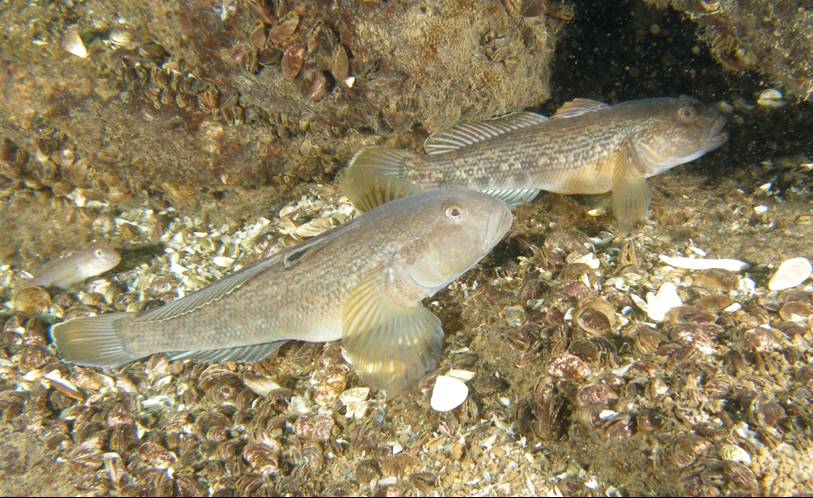
Round gobies amongst zebra mussel-covered rocks in
the St. Lawrence River. Photo by Sandra Warren.

EFFECTS
OF INTRODUCED PREDATORS ON LITTORAL FISH COMMUNITIES
Former MSc student Justin Trumpickas examined the
community-level impacts of predatory fishes introduced
to lakes in Algonquin Park mostly within the past few
decades. After controlling for other environmental
variables, his analysis showed that lakes with
introduced littoral predators (e.g., northern pike,
smallmouth bass, rock bass, walleye) contain fish
assemblages that differ conspicuously from those in
lakes without introduced predators. In lakes with
these predators, small-bodied species (e.g. minnows,
sticklebacks, dace) tend to be absent or severely
reduced in abundance. Surprisingly, introductions of
multiple species of predatory fishes to a lake seem to
have no additional effect on fish assemblages compared
with single predators. Therefore, if conservation
resources are limited, efforts to prevent predatory
fish introductions should be focused on lakes with no
littoral predatory fish already present. An unanswered
question is whether the addition of predators to lakes
that already contain introduced predatory fish would
have effects on other aquatic organisms, such as
amphibians and invertebrates. See our article in Aquatic
Conservation: Marine and Freshwater Ecosystems.
[December 2011].
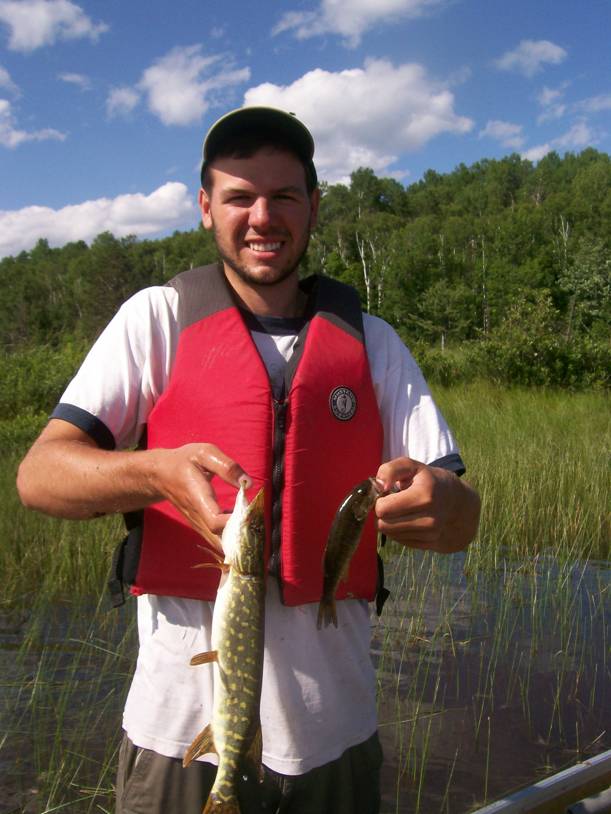
Justin holding specimens of northern pike and
smallmouth bass collected from a seine at Farm Lake,
Algonquin Park, Ontario. Photo courtesy of J.
Trumpickas.

WHY WE
SHOULD MANAGE INVASIONS AS NATURAL DISASTERS
In the April 2011 issue of BioScience,
my colleagues and I describe fundamental similarities
between biological invasions and natural disasters
that suggest these events should be managed with
similar precautions. Like natural disasters,
biological invasions are almost impossible to predict
and difficult to control once they occur. Invasions
can have more persistent impacts and a greater
capacity for ecological and economic damage; and yet,
systems of preparedness for invasions (except for
infectious diseases) are lacking in most countries.
Hazard-reduction plans, similar to those in place for
natural disasters, could minimize the impacts of
invasive species at a cost that is quite low relative
to the cost of an uncontrolled invasion [April 2011].
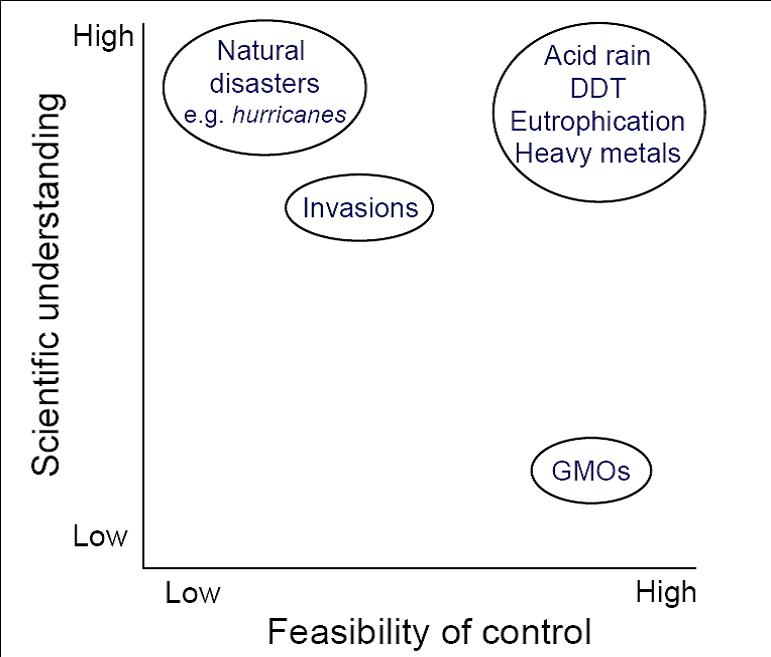
Environmental stressors vary with respect to the
degree to which they are understood and controlled.
As a result of a strong societal commitment to
address them, several stressors (e.g., acid rain,
DDT, heavy metals) are now well controlled. The
effects of genetically modified organisms (GMOs) are
poorly understood but potentially controllable
through enforceable legislation. Natural disasters
and invasions are both well understood, but
generally defy control.

NEW
FUNDING FOR THE CANADIAN AQUATIC INVASIVE SPECIES
NETWORK
Colleagues Brian Leung (McGill), Ladd Johnson (Univ.
Laval) and I are members of a team of Canadian
scientists that has received $6.5 million from the
Natural Sciences and Engineering Research Council to
study aquatic invasions in Canada's lakes, rivers and
coastal marine habitats. This will launch the second
phase of the Canadian Aquatic Invasive Species Network
(CAISN),
which began in 2006. The network consists of 30
members from 12 universities. A cohort of new graduate
students funded by CAISN-II will begin work in my lab
in the Fall 2011. Some of these students will be working on
projects co-supervised by Brian and Ladd. [February
2011]
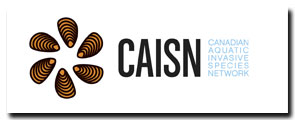

DIFFERENTIAL
FUNCTIONAL RESPONSES EXPLAIN COEXISTENCE OF INVASIVE
AND NATIVE CRUSTACEANS
A new study by Åsa Kestrup compares intraguild
predation (IGP) by invasive and native amphipods (Echinogammarus
ischnus and Gammarus fasciatus,
respectively) on each other's juveniles in high- and
low- conductivity water. The native amphipod had a
higher type-II functional response towards the
invasive amphipod's juveniles than vice versa.
Contrary to expectations and our previous work
examining IGP amongst the adults, conductivity did not
influence the predation rate on juveniles of either
species. Previous work in our lab (Kestrup &
Ricciardi 2009) showed the invader to be the dominant
predator in high-conductivity water and the native to
be dominant in low-conductivity water. The results of
this new study reveal that the native amphipod's
advantage at lower conductivities is compounded by
asymmetric predation on juveniles, which also
counteracts the invasive amphipod's advantage in
high-conductivity waters, helping to explain observed
patterns of co-existence. This study was done in
collaboration with Dr. Jaimie Dick of Queen's
University Belfast. See our article in Biological
Invasions. [January 2011]

Functional responses of Gammarus fasciatus
(native amphipod, in blue) and Echinogammarus
ischnus (invasive amphipod, in red) after 40h.
Solid lines = low conductivity; dashed lines = high
conductivity.

THE
ASIAN CLAM AND OTHER EXOTIC INVERTEBRATES IN A
THERMAL PLUME IN THE ST. LAWRENCE RIVER
MSc candidate Rowshyra Castaneda has begun
investigating the distribution and abundance of exotic
molluscs and crustaceans in a section of the St.
Lawrence River affected by thermal discharge from a
nuclear power plant at Bécancour, Quebec. In 2009, the
Asian clam Corbicula fluminea – one of the
world's most invasive aquatic invertebrates – was
discovered in the thermal plume by Dr. Anouk Simard
and colleagues at Quebec's Ministère des Ressources
naturelles et de la Faune. The species has not been
previously reported from the river. We are
collaborating with Dr. Simard to examine the
occurrence, condition and abundance of this species
and other invaders along the temperature gradient
created by the power plant. [October 2010]
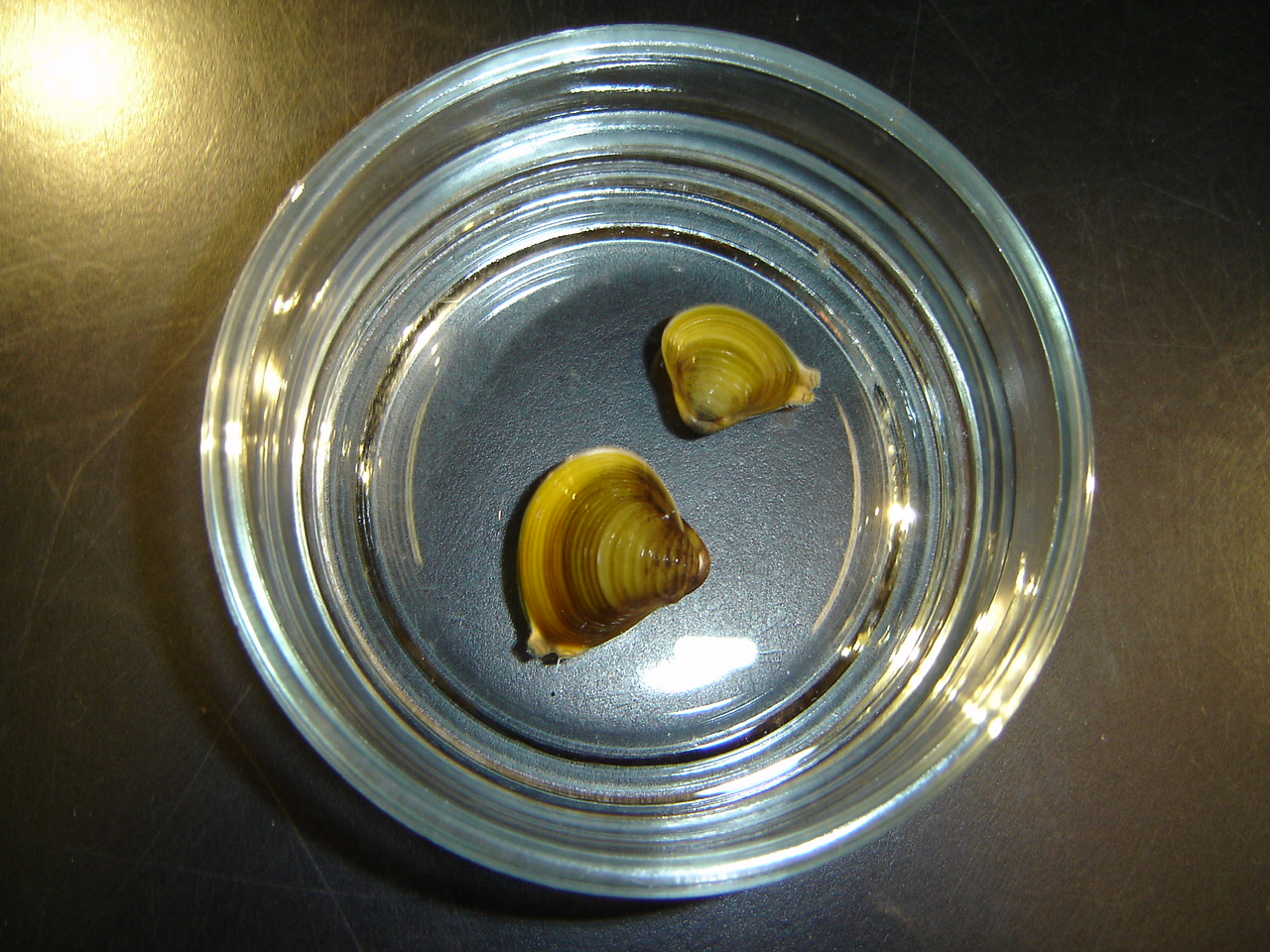
Two specimens of Corbicula collected by
Rowshyra Castaneda from the St. Lawrence River at
Bécancour, Quebec. Photo by A. Ricciardi.

TWO
NEW PHDs LEAVE THE RICCIARDI LAB
Congratulations to Åsa Kestrup and Jessica Ward for
successfully defending their doctoral dissertations,
on January 19 and April 1, 2010, respectively. Åsa's
thesis examined the effects of interspecific
interactions and environmental heterogeneity on the
dominance of a Ponto-Caspian crustacean (Echinogammarus
ischnus) in the St. Lawrence River. She
subsequently completed a contract with the Quebec
Centre for Biodiversity Science, and has been hired as
a science advisor in the Department of Fisheries and
Oceans. Jessica's thesis investigated the
community-level impacts of nonindigenous ecosystem
engineers in freshwater and marine habitats. She
has been hired as an ecologist at AECOM, an
international consulting firm. Based on their
accomplishments to date, we anticipate that both Åsa
and Jess will have productive careers.

A
CRYPTOGENIC PARASITE DIFFERENTIALLY INFECTS EXOTIC
AMPHIPODS IN THE ST. LAWRENCE RIVER
While sampling amphipod populations in the St.
Lawrence River, Åsa Kestrup observed mysterious mass
die-offs of amphipods, particularly involving the
exotic species Echinogammarus ischnus.
Amphipods that had been brought back from the field
were also rapidly dying in the lab. The culprit
appears to be a parasitic water mold of unknown
origin. Samples were sent to Dr. Meghan Duffy's lab
(Georgia Tech.) for genetic analysis, and the parasite
was identified as a species closely related to Saprolegnia,
but we cannot determine whether it is native or
introduced to the St. Lawrence. In laboratory
experiments, infection prevalence was found to be
higher in live E. ischnus than in native
amphipods; furthermore, dead E. ischnus
individuals exhibited more intense infections than the
natives. Therefore, this pathogenic parasite could be
facilitating the co-existence of the two amphipod
species in the river, by reducing the exotic species
in ion-rich waters where it would otherwise be
dominant. Our findings will be published in the
journal Biological
Invasions. [August 2010]
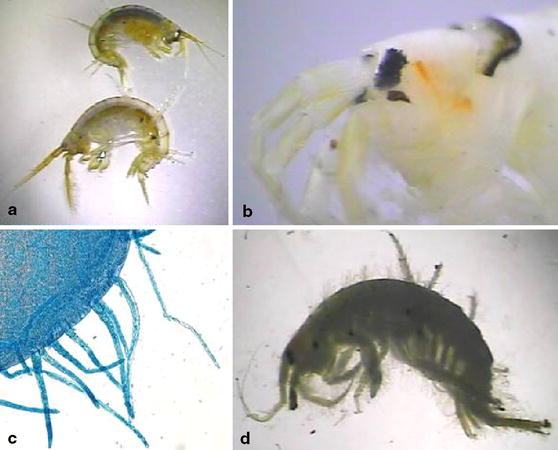
(a) Infected live female (top) and male
(bottom) E. ischnus with melanized spots; (b)
newly dead E. ischnus; (c) hyphae
growing out from a gill; and (d) a dead E.
ischnus overgrown with hyphae. Photos by Å Kestrup.

A
NATIVE HABITAT-MODIFYING SPECIES OBSCURES THE
EFFECTS OF INVASIVE MUSSELS
Introduced ecosystem engineers can substantially alter
native communities by transforming the physical
structure of habitats. In the Great Lakes and St.
Lawrence River, invasive dreissenid (zebra and quagga)
mussels commonly occur with the native benthic
macroalga Cladophora, and both act as
ecosystem engineers by increasing substratum
complexity and providing interstitial habitat for
benthic macroinvertebrates. In a series of experiments
in the St. Lawrence River, PhD student Jessica Ward
manipulated the topography of patches of dreissenid
mussel shells on artificial substrates that were
deployed to be colonized by other organisms. She found
that the patchiness of dreissenid mussels is an
important driver of variation in benthic invertebrate
diversity at small spatial scales, but that
colonization by Cladophora modifies the
impacts of the mussels on other invertebrates, leading
to community responses that differ markedly from those
observed in the absence of the macroalga. Her findings
thus demonstrate that interactions between
habitat-modifying species can complicate efforts to
predict the community-level effects of an invasion.
Her article will appear in an upcoming issue of the
journal Freshwater
Biology. [February 2010]
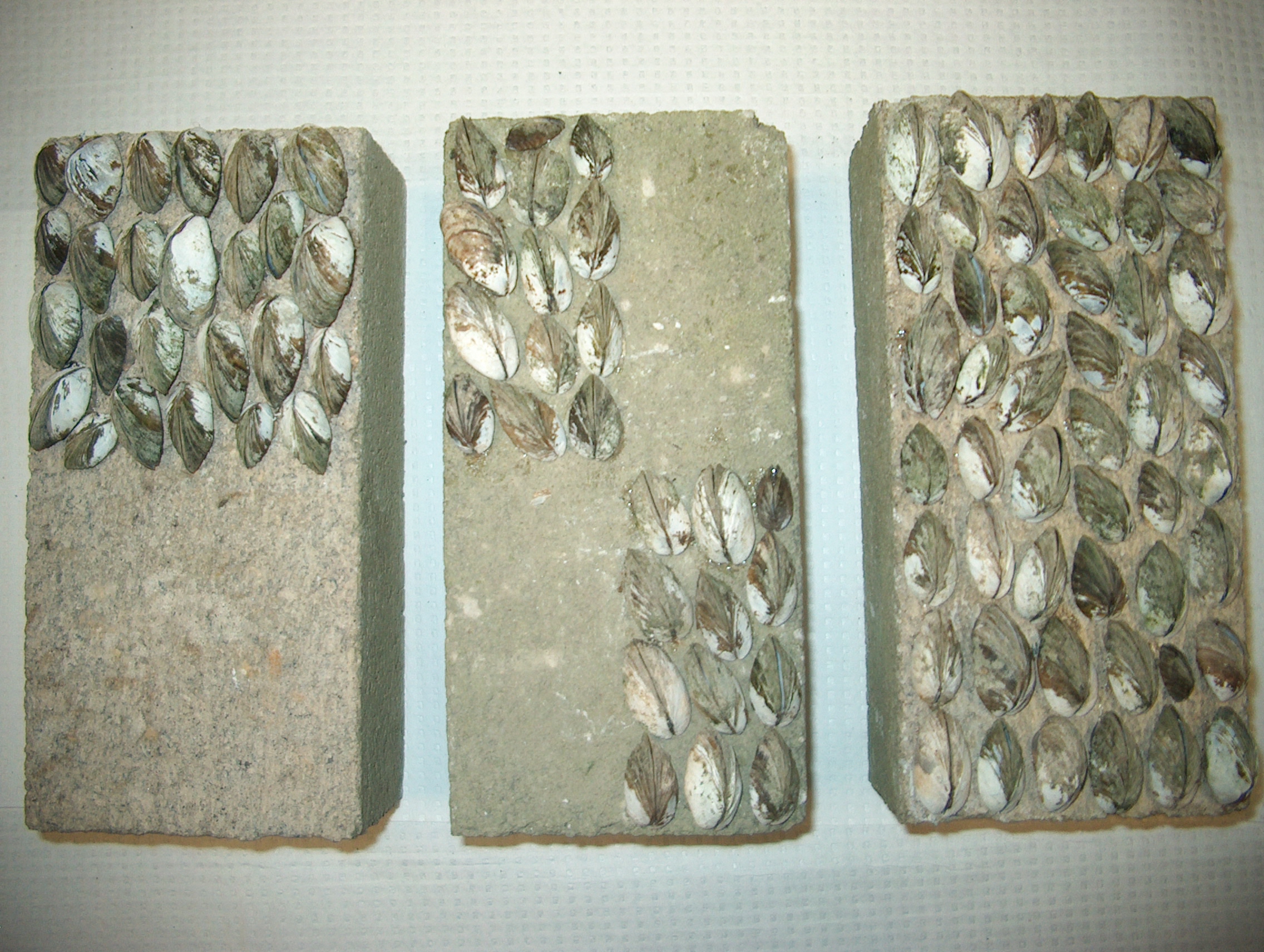 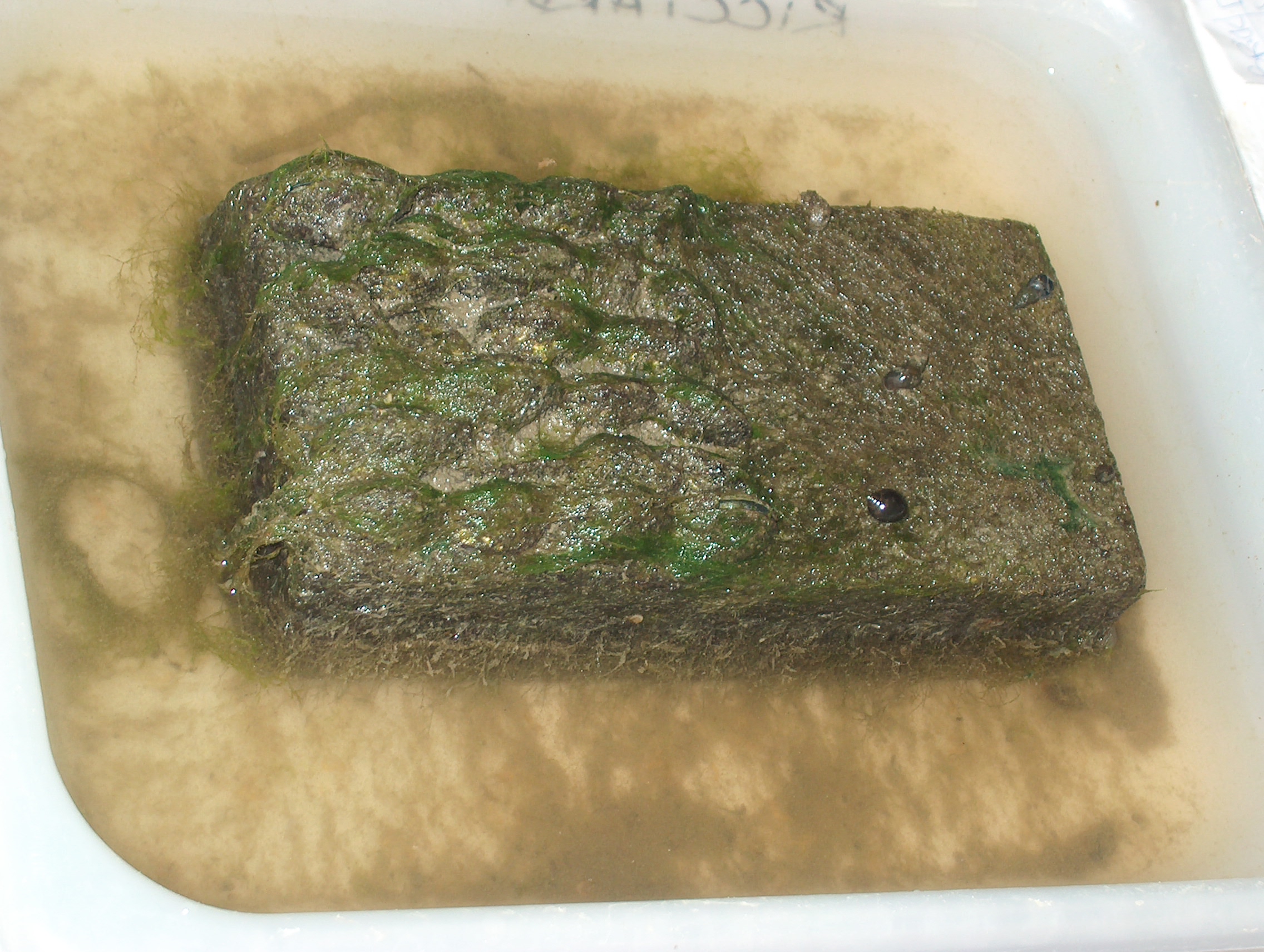
Left: Experimental substrates: Half-cover,
checkered, and full-cover shell treatments.
Right: Half-cover shell treatment colonized by
Cladophora and invertebrates at the end of the
experiment. Photos by J. Ward.

INTERCONTINENTAL
DISPERSAL OF FRESHWATER BRYOZOANS BY SHIPS
The transport of organisms in ships’ ballast tanks is
a dominant vector of aquatic invasions worldwide.
Until recently, efforts to manage this vector have
overlooked the potential transport of invertebrate
resting stages in the residual waters and sediments
within emptied ballast tanks, i.e. NOBOB ('No Ballast
On Board') tanks (Ricciardi
& MacIsaac 2008). For example, freshwater
bryozoans have resting stages (statoblasts) that are
often buoyant and locally abundant, and thus can be
taken up easily during ballasting operations.
Statoblasts are also resistant to extreme
environmental conditions and can generate a new
bryozoan colony even after being dormant for decades.
Therefore, they would likely remain viable propagules
after lengthy transport in ship ballast tanks.
In collaboration with Drs. Hugh MacIsaac and Sarah
Bailey (University of Windsor), MSc student Rebekah
Kipp and I quantified the diversity and abundance of
freshwater bryozoan statoblasts in NOBOB tanks of
transoceanic ships visiting the Great Lakes. We
identified 11 species, which represent an astonishing
fraction (12%) of the number of freshwater bryozoans
known worldwide. These include two exotic species
unrecorded in the Great Lakes (Fredericella sultana
and Lophopus crystallinus). We also found an
exotic species already established in the region (Lophopodella
carteri), and three cosmopolitan species (Plumatella
casmiana, P. fungosa and P. repens),
which indicates the potential for cryptic invasions
via the introduction of exotic genotypes. Our
estimates suggest that a ship with NOBOB tanks may
carry up to 106 statoblasts, posing a
significant risk of new species introductions.
The study has been published in the journal Diversity and
Distributions. [January 2010]
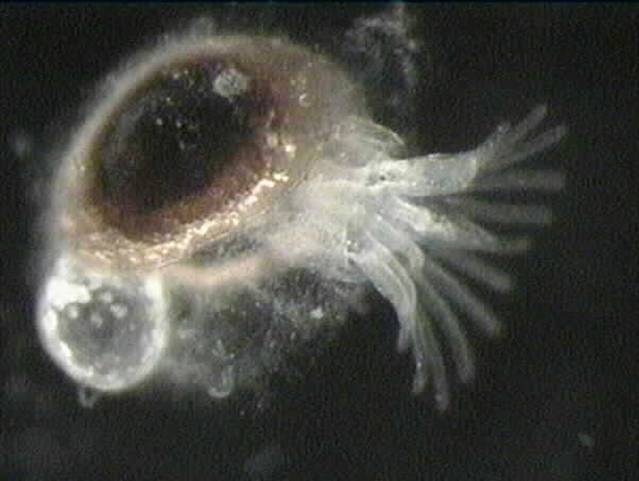
A bryozoan (Plumatella casmiana), newly
hatched in the laboratory from a statoblast
retrieved from ballast tank sediments. Photo by S.
Bailey.

WATER
CHEMISTRY MEDIATES PREDATORY INTERACTIONS BETWEEN
INVASIVE AND NATIVE CRUSTACEANS
PhD student Åsa Kestrup has discovered a previously
undocumented predatory interaction between invasive
and native crustaceans in the St. Lawrence
River. Ten years after it began colonizing the
river, an invasive freshwater amphipod Echinogammarus
ischnus has replaced a native amphipod Gammarus
fasciatus at some sites, but not at others. The
mechanism and pattern of replacement are poorly
understood. Recent experiments in the laboratory and
at field sites in the river have revealed that the two
species are mutual predators, with the males of one
species attacking and killing the females of the other
species (see photo). What is particularly
intriguing is that the direction and magnitude of this
interaction vary with the conductivity of the water.
The invasive species is the superior predator in
ion-rich waters, while the native species is superior
at lower conductivities at sites near the Island of
Montreal. Thus, mixed flows caused by the convergence
of the ion-rich St. Lawrence River with the ion-poor
Ottawa River create a chemically heterogeneous system
that may be responsible for spatial variation in the
relative dominance of the two species. The article
appears in the journal Biological
Invasions. [October 2009]
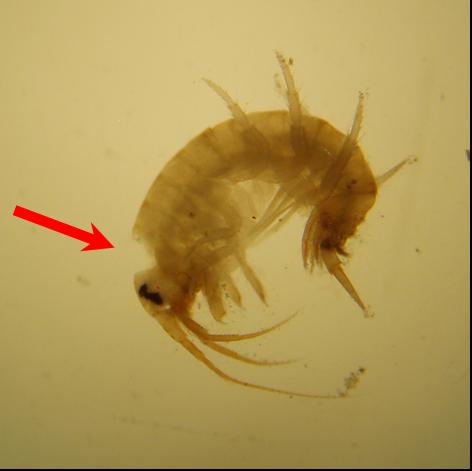
A female invasive amphipod (E. ischnus),
killed by a native male amphipod (G.
fasciatus). The arrow points to predation damage.
Photo by Å Kestrup.

A
CRITIQUE OF 'ASSISTED COLONIZATION'
In recent years, several biologists have proposed
intentional large-scale translocations of species as a
strategy to conserve threatened species or to enhance
the biodiversity of a target region. They assert that
carefully planned translocations (termed 'assisted
colonization', 'assisted migration', or 'managed
relocation') guided by decision frameworks and risk
assessments would reduce the potential hazards
associated with introductions of nonindigenous
species. In an article in Trends
in Ecology and Evolution, Dan
Simberloff and I argue that conservation biologists
have not yet developed a sufficient understanding of
the impacts of introduced species to make safe
decisions regarding their translocation. The
literature documents myriad examples of planned
invasions that have produced unintended and
unpredictable consequences. Until we develop more
accurate and general methods of predicting impact,
risk assessments could be dangerously misleading and
assisted colonization strategies amount to ecological
gambling.
Our paper was selected as a "must read" article by the
Faculty
of 1000 Biology, and has provoked an exchange of
letters
in the September issue of TREE. [August
2009]
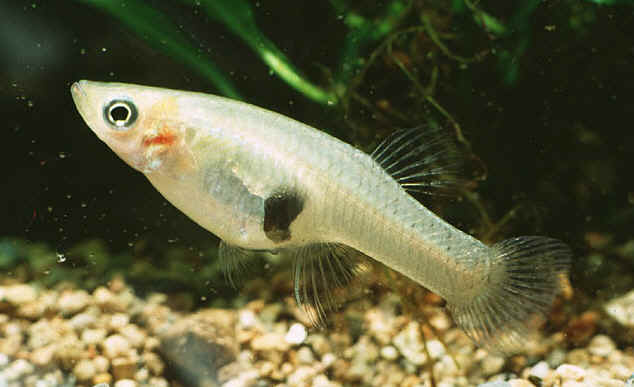
One serious ecological risk posed by assisted
colonization is increased hybridization. Many
species of birds, fishes, mammals and plants became
genetically diluted or completely assimilated when
they were brought into contact with relatives from
which they were previously isolated. For example, an
endemic North American fish, the Amistad gambusia
Gambusia amistadensis, was hybridized to extinction
when it came into contact with another North
American species, the western mosquitofish G.
affinis (shown above). Hybridization with
introduced relatives is assumed to be at least
partially responsible for over 30% of North American
freshwater fish extinctions. Photo by C. Appleby,
USGS.

INVASIVE
PONTO-CASPIAN SHRIMP FOUND IN THE ST. LAWRENCE RIVER
PhD student Åsa Kestrup has made another discovery:
the invasive Ponto-Caspian mysid shrimp, Hemimysis
anomala, is recorded for the first time in
the St. Lawrence River. The mysids were discovered in
sampling trays of cobble that were deployed on two
occasions at a site near Montreal this past summer in
order to collect amphipods. We did not detect their
presence until preserved samples were examined a few
months later. Specimens included gravid females and
juveniles, which suggest that the species is
reproducing in the river. Colonization of the river is
likely being driven by downstream dispersal of
individuals from Lake Ontario but, given the 250 km
distance from the outflow of the lake, it seems
probable that cryptic riverine populations exist
upstream of our site. This species has apparently
spread widely since being found in Lake Michigan and
Lake Ontario in 2006. In the past two years, H.
anomala has been recorded in all large
waterbodies within the Great Lakes-St. Lawrence basin,
except for Lake Superior. The St. Lawrence is the
first North American river to be invaded by the mysid.
See our article in the journal Aquatic
Invasions. [December 2008]

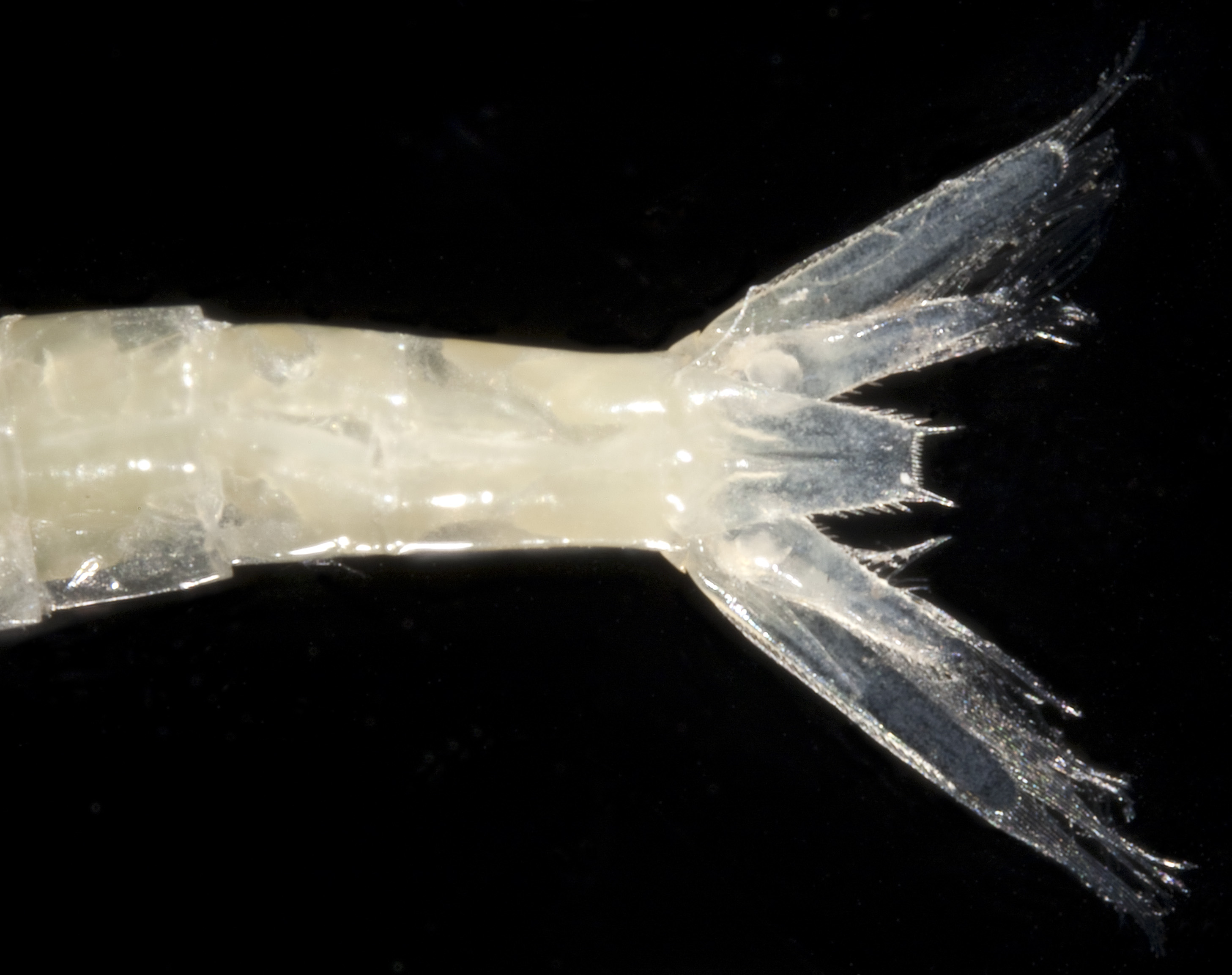
Top: A preserved adult female H.
anomala (7.5 mm in length) found in the St.
Lawrence River.
Bottom: Dorsal view of the truncated telson,
a distinguishing feature of the species. Photos by
Guy L'Heureux.

REPLACEMENT
OF NATIVE AQUATIC PLANTS BY INVASIVE PLANTS ALTERS
INVERTEBRATE COMMUNITIES
Aquatic plants serve as habitat for dense communities
of invertebrates, and thus provide important feeding
grounds for fish in lakes and rivers. By sampling
native and exotic milfoils (Myriophyllum spp.)
at various sites, MSc graduate Sarah Wilson examined
whether the replacement of native plants by
closely-related exotic plants results in changes in
plant-associated invertebrate communities. She found
higher invertebrate diversity, higher invertebrate
biomass, and greater gastropod abundance on native
milfoils than on Eurasian milfoil. Her results
demonstrate that Eurasian milfoil supports
macroinvertebrate communities that differ from those
on closely-related and morphologically similar native
plants. Therefore, the ongoing replacement of native
milfoils by Eurasian milfoil may have indirect effects
on biodiversity and food webs in invaded waterbodies.
See our article in the Canadian
Journal of Fisheries and Aquatic Sciences.
[August 2008]
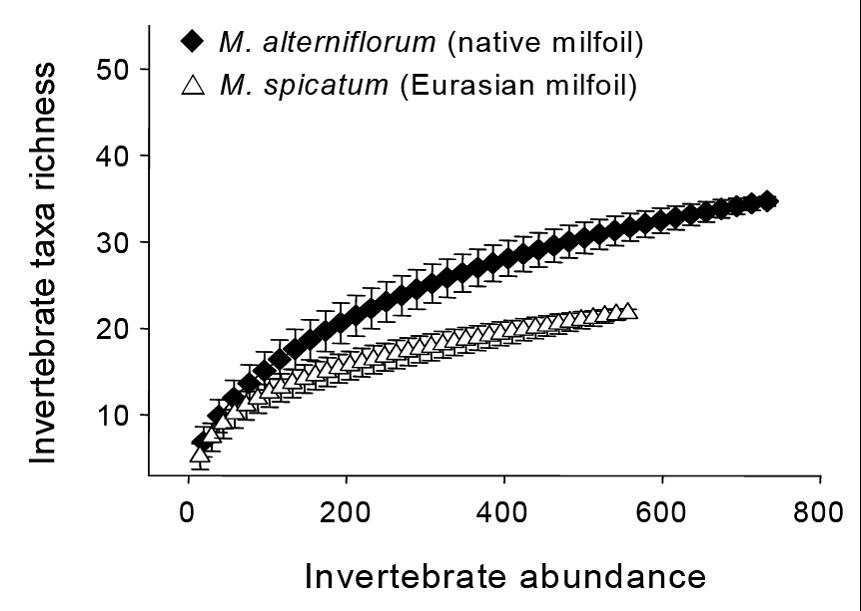
Rarefaction curves for invertebrate taxa on native
and exotic milfoils in Saranac Lake (Wilson &
Ricciardi 2009).

INVASIVE
ECOSYSTEM ENGINEERS
Exotic species can dominate communities and replace
native species that should be better adapted to their
local environment, a paradox that is usually explained
by the absence of their natural enemies and the
effects of anthropogenic disturbance. An alternative
explanation is that some exotic species can enhance
their invasion success and impact on native species by
altering the environment through ecosystem
engineering. A modelling study in collaboration with
Dr. Andy Gonzalez (McGill) and Dr. Amaury Lambert
(Ecole Normale Supérieure, Paris) explored competition
for habitat between a native non-engineering species
and an exotic engineering species. A key factor
was the invader's density dependence (how its rate of
engineering varied with its abundance), which
determined whether the invader co-existed with the
native species or drove it to extinction.
Another intriguing result is that a series of failed
invasions can successively reduce environmental
resistance to subsequent invasion, through a
cumulative effect of ecosystem engineering. See
our recent article in Oikos.
[July 2008]

A nonlinear result of our modelling study. Change
in abundance for a resident species (thick solid
line) and its natural habitat (thin solid line) in
response to an invasive engineer (dashed line) and
its engineered habitat (dotted line) (Gonzalez et
al. 2008).

PREDICTING
IMPACTS OF ZEBRA MUSSELS FROM PHYSICAL HABITAT
VARIABLES
The impacts of invaders vary across space and time,
posing a formidable challenge to risk assessment.
However, sometimes only a few key environmental
variables may be important for predicting impact. This
may be the case for the zebra mussel's impact on
native bivalve populations, which is largely related
to the level of fouling by zebra mussels attached to
the shells of native species. Anneli Jokela, a former
MSc student, has shown that the fouling intensity of
zebra mussels is positively correlated with calcium
concentration and negatively correlated to the mean
particle size of surrounding sediments. This
finding suggests that habitats whose native
populations are most vulnerable to zebra mussel
impacts can be identified in advance of
invasion. See our article in Freshwater
Biology. [April 2008]
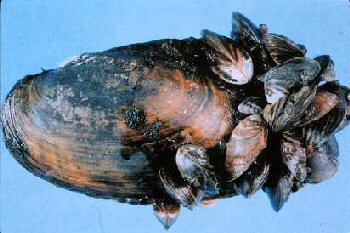
A native unionid bivalve, Lampsilis radiata,
fouled by zebra mussels. It was collected from the
upper St. Lawrence River in 1993. Photo by A.
Ricciardi.

ELTON'S
LEGACY: THE BOOK THAT FOUNDED INVASION ECOLOGY
This year is the 50th anniversary of the publication
of Charles Elton's classic text The Ecology of Invasions
by Animals and Plants (Methuen, 1958), the
book that pioneered an entire field of research.
Over the past half century, its influence has grown
exponentially (like an invasive species population)
and is cited now more than ever before. Read our
retrospective article in Nature.
[March 2008]
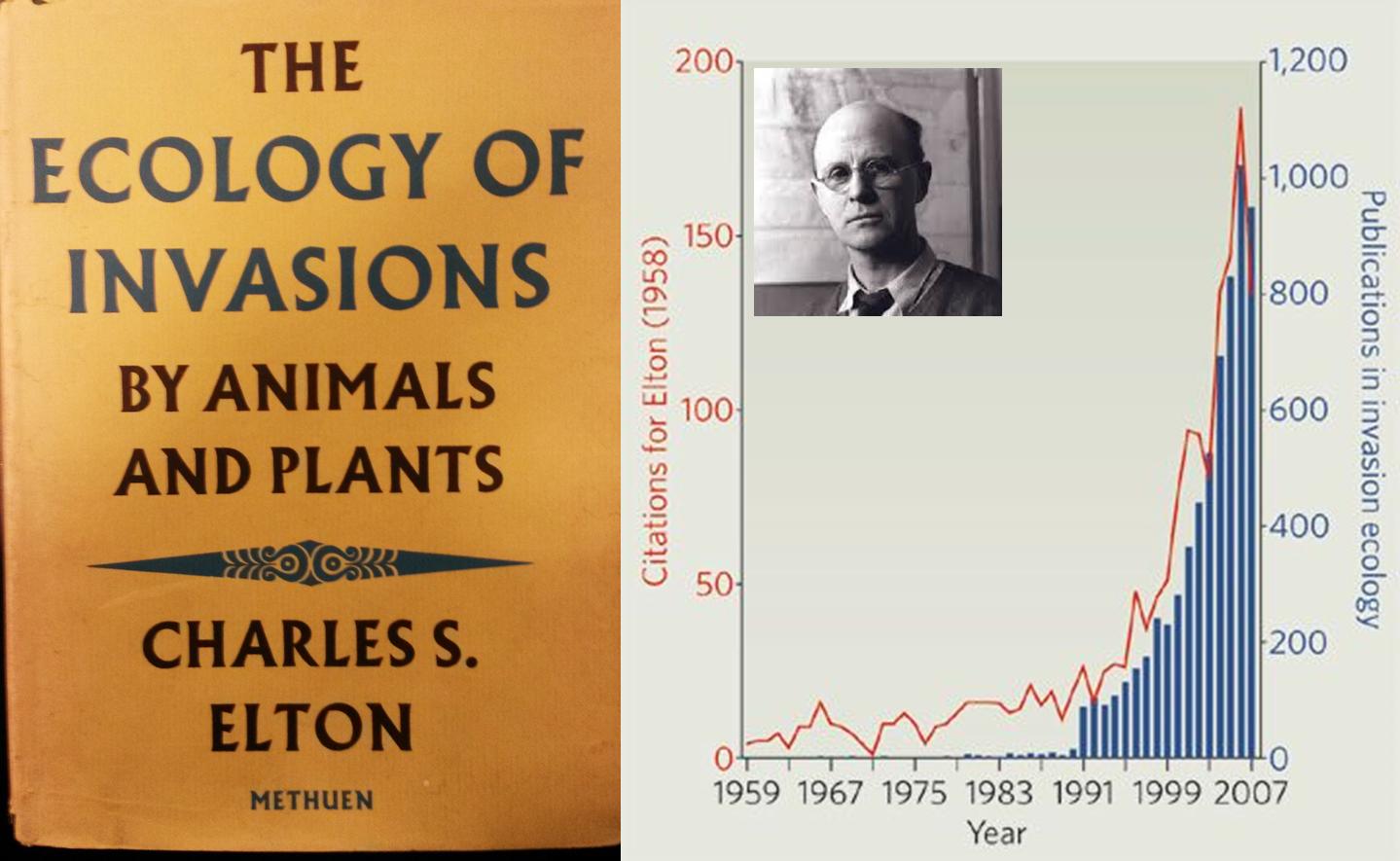

GREAT
LAKES' DATABASE LAUNCHED
NOAA's Great Lakes Environmental Research Laboratory
has created the most comprehensive database available
for Great Lakes invaders. The Great Lakes Aquatic
Nonindigenous Species Information System (GLANSIS)
provides information on the distribution, life history
and known impacts of most of the invaders reported in
the basin. A major contributor to the database was
Rebekah Kipp, a research assistant in our lab (and
soon to be a graduate student in January 2008) who
compiled information for over 80 exotic species of
invertebrates, fishes, plants and algae. An
example of one of these factsheets can be found here
for the VHS virus - an invasive pathogen of major
concern for Great Lakes fisheries. Search GLANSIS
for your invader of interest. [December 2007]
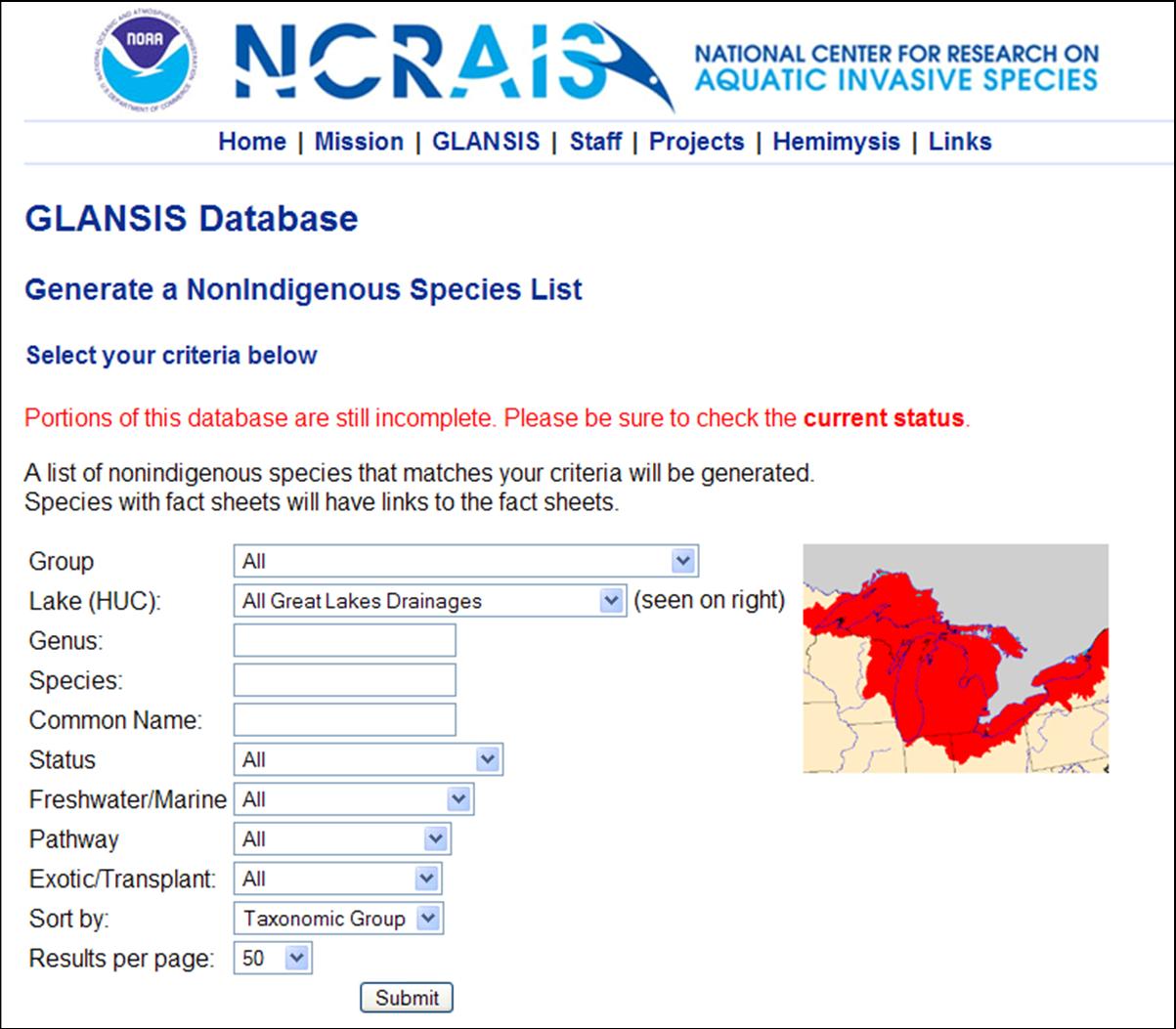

OUR
RESEARCH ON FILM
The American Museum of Natural History has produced a
short documentary film called Invasive Species,
which features research by graduate students in our
lab (as well as students in Dr. David Lodge's lab at
the University of Notre Dame). This past summer, the
filmmakers followed a team of divers led by my PhD
students Lisa Jones and Åsa Kestrup to a field site
where we conduct work on zebra mussels, quagga
mussels, round gobies and Ponto-Caspian amphipods. The
film is one of the "Bio Features" that can be viewed
on the AMNH
website. [November 2007]
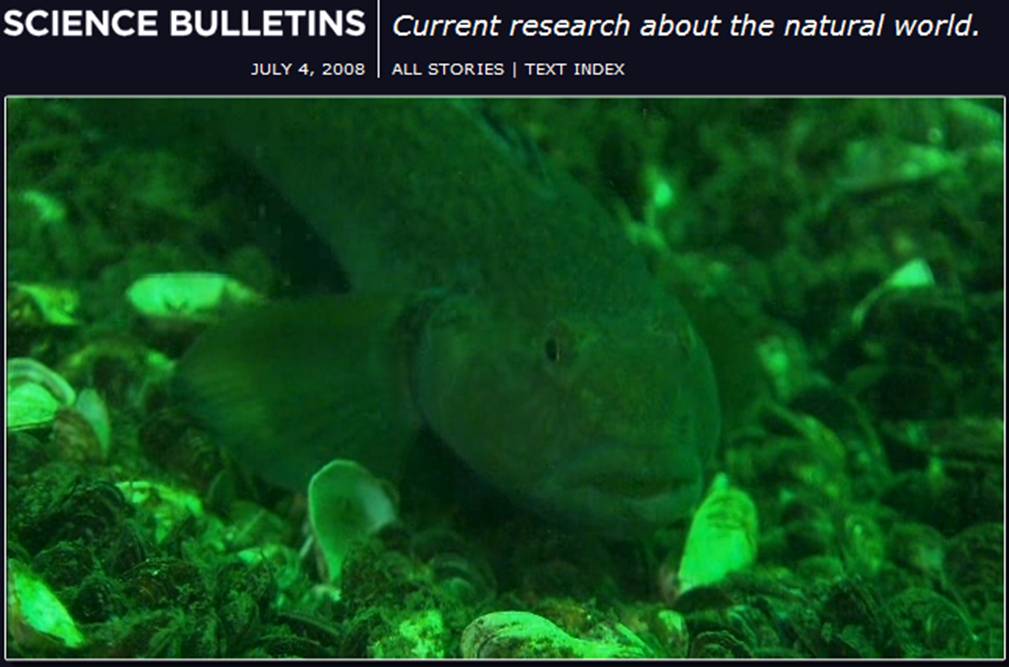

CONTRADICTING
DARWIN
Through a meta-analysis of published data, PhD student
Jessica Ward and I tested the popular assumption that
native herbivores are more likely to suppress plant
invaders that are closely-related to native species –
an idea originally proposed by Darwin. Contrary to
Darwin's hypothesis, the impact of native herbivores
is several times stronger on introduced plants that
are exotic genera in the invaded region than on
introduced plants that share genera with native plants
in the region! Exotic plants may be pre-adapted to the
conditions of herbivory experienced by native species
of the same genus. Our finding highlights the
potential importance of evolutionary naivete in
mediating the interactions between exotic and native
species. See our article in Science and
a commentary
[July 2006]
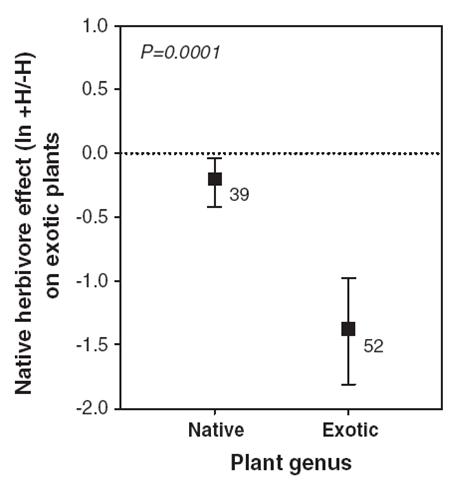

INCREASING
RATE OF DISCOVERY OF GREAT LAKES' INVADERS
The
composition and number of invaders discovered in the
Great Lakes at different periods during the past two
centuries are correlated to changes in vector
activity, particularly overseas shipping. Ballast
water management has not halted the influx of
ship-vectored invaders into the Great Lakes, but
rather has altered the composition of invaders to
favor benthic invertebrates with broad salinity
tolerance. The rate of species discovery suggests that
the Great Lakes basin is among the most highly invaded
aquatic systems in the world. Read the published
study here.
[July 2006]
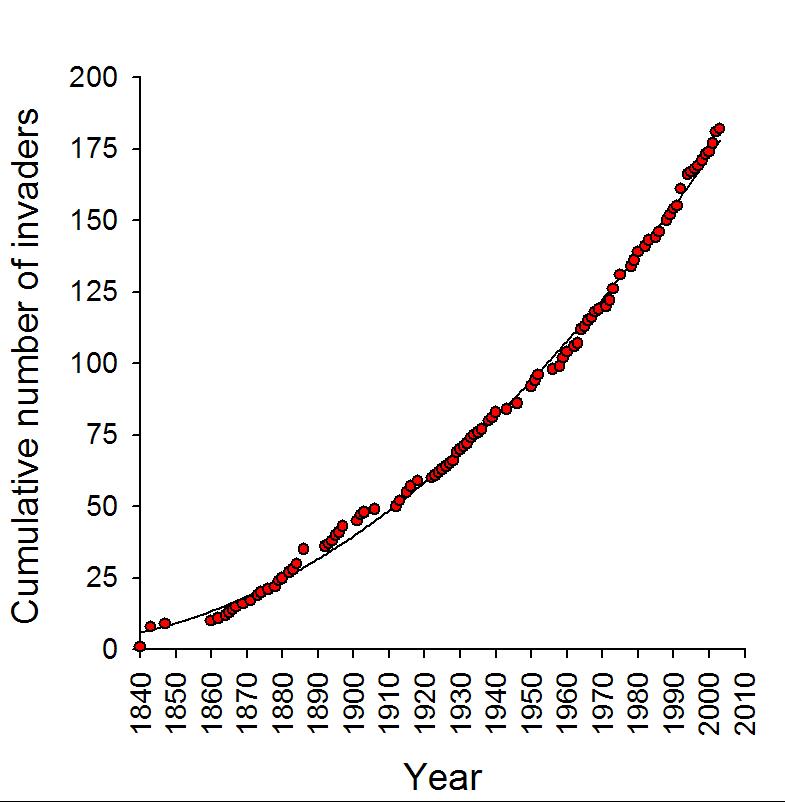
|
